Sony GDM-F520, GDM-F420 User Manual

4-080-794-11 (1)
Trinitronâ Color
Graphic Display
Operating Instructions |
|
|
|
GB |
|||||
|
|
|
|
||||||
|
|
|
|
|
|
|
|
|
|
Mode d’emploi |
|
|
|
|
|
|
|
|
FR |
|
|
|
|
|
|
|
|
||
|
|
|
|
|
|||||
Bedienungsanleitung |
|
|
|
|
DE |
||||
|
|
|
|
||||||
|
|
|
|
||||||
Manual de instrucciones |
|
|
ES |
||||||
|
|
|
|
|
|||||
Istruzioni per l’uso |
|
|
|
|
|
|
IT |
||
|
|
|
|
||||||
|
|
|
|||||||
Инструкция по эксплуатации |
|
RU |
|||||||
|
|
||||||||
|
|
|
|
||||||
Bruksanvisning |
|
|
|
|
|
|
|
SE |
|
|
|
|
|||||||
|
|
|
|||||||
Gebruiksaanwijzing |
|
|
|
|
|
NL |
|||
|
|
||||||||
GDM-F520
GDM-F420
© 2000 Sony Corporation
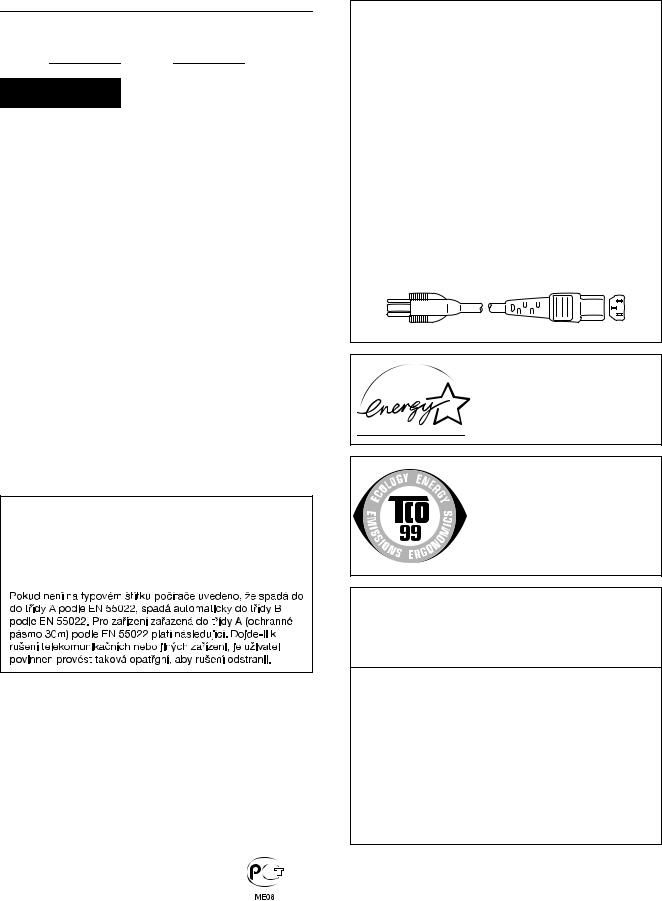
Owner’s Record
The model and serial numbers are located at the rear of the unit. Record these numbers in the spaces provided below. Refer to them whenever you call upon your dealer regarding this product. Model No. Serial No.
WARNING
To prevent fire or shock hazard, do not expose the unit to rain or moisture.
Dangerously high voltages are present inside the unit. Do not open the cabinet. Refer servicing to qualified personnel only.
FCC Notice
This equipment has been tested and found to comply with the limits for a Class B digital device, pursuant to Part 15 of the FCC Rules. These limits are designed to provide reasonable protection against harmful interference in a residential installation. This equipment generates, uses, and can radiate radio frequency energy and, if not installed and used in accordance with the instructions, may cause harmful interference to radio communications. However, there is no guarantee that interference will not occur in a particular installation. If this equipment does cause harmful interference to radio or television reception, which can be determined by turning the equipment off and on, the user is encouraged to try to correct the interference by one or more of the following measures:
–Reorient or relocate the receiving antenna.
–Increase the separation between the equipment and receiver.
–Connect the equipment into an outlet on a circuit different from that to which the receiver is connected.
–Consult the dealer or an experienced radio/TV technician for help.
You are cautioned that any changes or modifications not expressly approved in this manual could void your authority to operate this equipment.
EN 55022 Compliance (Czech Republic Only)
This device belongs to category B devices as described in EN 55022, unless it is specifically stated that it is a category A device on the specification label. The following applies to devices in category A of EN 55022 (radius of protection up to 30 meters). The user of the device is obliged to take all steps necessary to remove sources of interference to telecommunication or other devices.
INFORMATION
This product complies with Swedish National Council for Metrology (MPR) standards issued in December 1990 (MPR II) for very low frequency (VLF) and extremely low frequency (ELF).
INFORMATION
Ce produit est conforme aux normes du Swedish National Council for Metrology de décembre 1990 (MPR II) en ce qui concerne les fréquences très basses (VLF) et extremement basses (ELF).
INFORMACIÓN
Este producto cumple las normas del Consejo Nacional Sueco para Metrología (MPR) emitidas en diciembre de 1990 (MPR II) para frecuencias muy bajas (VLF) y frecuencias extremadamente bajas (ELF).
NOTICE
This notice is applicable for USA/Canada only.
If shipped to USA/Canada, install only a UL LISTED/CSA LABELLED power supply cord meeting the following
specifications: |
|
SPECIFICATIONS |
|
Plug Type |
Nema-Plug 5-15p |
Cord |
Type SVT or SJT, minimum 3 × 18 AWG |
Length |
Maximum 15 feet |
Rating |
Minimum 7 A, 125 V |
NOTICE
Cette notice s’applique aux Etats-Unis et au Canada uniquement.
Si cet appareil est export* aux Etats-Unis ou au Canada, utiliser le cordon d’alimentation portant la mention UL LISTED/ CSA LABELLED et remplissant les conditions suivantes: SPECIFICATIONS
Type de fiche Cordon Longueur Tension
As an ENERGY STAR Partner, Sony Corporataion has determined that this product meets the ENERGY STAR guidelines for energy efficiency.
This monitor complies with the TCO’99 guidelines.
If you have any questions about this product, you may call: Sony Customer Information Center
1-800-222-SONY (7669) or write to:
Sony Customer Information Center
1 Sony Drive, Mail Drop #T1-11, Park Ridge, NJ 07656
Declaration of Conformity
Trade Name: |
SONY |
Model No.: |
GDM-F520/F420 |
Responsible Party: |
Sony Electronics Inc. |
Address: |
1 Sony Drive, Park Ridge, NJ 07656 USA |
Telephone No.: |
201-930-6972 |
This device complies with Part 15 of the FCC Rules. Operation is subject to the following two conditions: (1) This device may not cause harmful interference, and (2) this device must accept any interference received, including interference that may cause undesired operation.
2
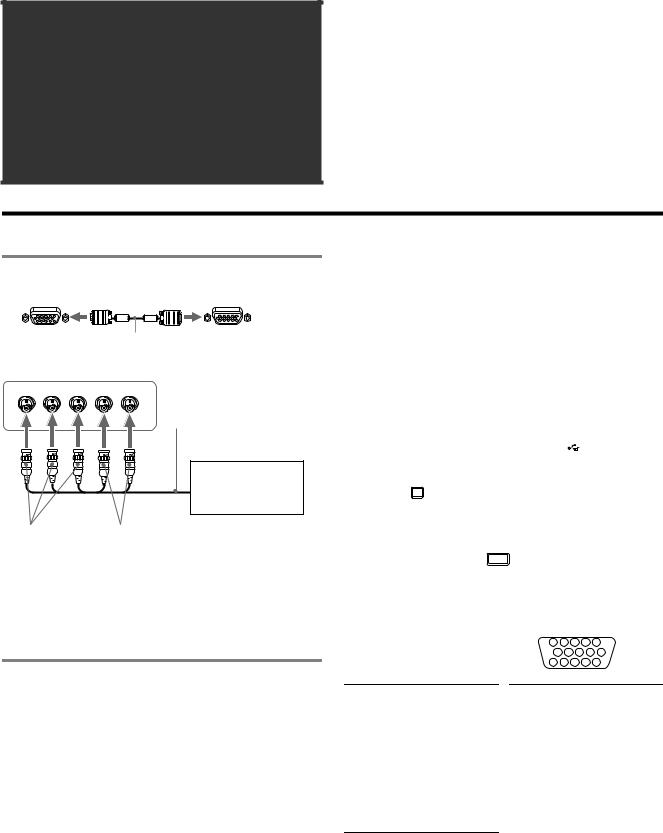
Table of Contents
Setup . . . . . . . . . . . . . . . . . . . . . . . . . . . . . . . . . . . 3
Adjustments . . . . . . . . . . . . . . . . . . . . . . . . . . . . . 4
Troubleshooting . . . . . . . . . . . . . . . . . . . . . . . . . . 6
Specifications . . . . . . . . . . . . . . . . . . . . . . . . . . . . 7
Precautions . . . . . . . . . . . . . . . . . . . . . . . . . . . . . . 8
Appendix . . . . . . . . . . . . . . . . . . . . . . . . . . . . . . . . . i
Preset mode timing table . . . . . . . . . . . . . . . . . . . . . i TCO’99 Eco-document . . . . . . . . . . . . . Back Cover
•Trinitronâ is a registered trademark of Sony Corporation.
•Macintosh is a trademark licensed to Apple Computer, Inc., registered in the U.S.A. and other countries.
•Windowsâ and MS-DOS are registered trademarks of Microsoft Corporation in the United States and other countries.
•IBM PC/AT and VGA are registered trademarks of IBM Corporation of the U.S.A.
•VESA and DDCä are trademarks of the Video Electronics Standard Association.
•ENERGY STAR is a U.S. registered mark.
•All other product names mentioned herein may be the trademarks or registered trademarks of their respective companies.
•Furthermore, “ä” and “â” are not mentioned in each case in this manual.
Setup
1 Connecting your monitor to your computer
x To connect to the HD15 input connector
to HD15 |
video signal cable |
to HD15 of the |
|
(supplied) |
connecting computer |
x To connect to the 5 BNC connectors
R G B HD VD
video signal cable (not supplied)
Refer to the preceding examples to connect to your computer.
to VIDEO IN R/G/B |
to SYNC IN HD/VD |
Connecting to a Macintosh or compatible computer
When connecting this monitor to a Power Mac G3/G4 computer, use the supplied adapter if necessary. Connect the supplied adapter to the computer before connecting the cable. If you connect to another version of Macintosh series computer, having 2 rows of pins, you will need a different adapter (not supplied).
2 Turning on the monitor and computer
1 Connect the power cord to the monitor and press the ! (power) switch to turn on the monitor.
2 Turn on the computer.
No need for specific drivers
This monitor complies with the “DDC” Plug & Play standard and automatically detects all the monitor’s information. No specific driver needs to be installed to the computer.
The first time you turn on your PC after connecting the monitor, the setup Wizard may appear on the screen. In this case, follow the on-screen instructions. The Plug & Play monitor is automatically selected so that you can use this monitor.
Notes
•Plug and Play is compatible with the HD15 connector only, and not compatible with the 5 BNC connectors.
•Do not touch the pins of the video signal cable connector.
•Check the alignment of the HD15 connector to prevent bending the pins of the video signal cable connector.
To select the input signal
You can connect two computers to this monitor using the HD15 and BNC connectors. To select one of the two computers, use the INPUT switch. The selected connector appears on the screen for 3 seconds.
Note
If no signal is input to the selected connector, NO SIGNAL appears on the screen. After a few seconds, the monitor enters the power saving mode. If this happens, switch to the other connector.
To connect Universal Serial Bus (USB) compliant |
GB |
|||
|
||||
peripherals |
|
|
|
|
Confirm that the monitor and computer are turned on, then |
|
|||
connect your computer to the USB connectors ( |
|
) on the right side |
|
|
|
|
|||
of the monitor. |
|
|
|
|
Connect your computer to the square upstream |
|
|||
connector ( ) using the supplied USB cable. |
|
|||
If a Windows message appears, follow the on-screen instructions |
|
|||
and select “Generic USB Hub”. |
|
|
|
|
When connecting your USB compliant peripheral devices (e.g., |
|
|||
printer, keyboard, mouse, scanner, etc.) connect the rectangular |
|
|||
downstream USB connector ( |
). |
|
|
|
Note
The monitor functions as a USB hub as long as the monitor is either “on” or in power saving mode.
HD15 input connectors
5 4 3 2 1
10 9 8 7 6
15 14 13 12 11
Pin No. |
Signal |
1 |
Red |
|
|
2 |
Green (Sync on |
|
Green) |
3 |
Blue |
|
|
4 |
ID (Ground) |
|
|
5 |
DDC Ground* |
|
|
6 |
Red Ground |
|
|
7 |
Green Ground |
|
|
8 |
Blue Ground |
Pin No. |
Signal |
9 |
DDC + 5V* |
|
|
10 |
Ground |
|
|
11 |
ID (Ground) |
|
|
12 |
Bi-Directional |
|
Data (SDA)* |
|
|
13 |
H. Sync |
|
|
14 |
V. Sync |
|
|
15 |
Data Clock |
|
(SCL)* |
* DDC (Display Data Channel) is a standard of VESA.
3
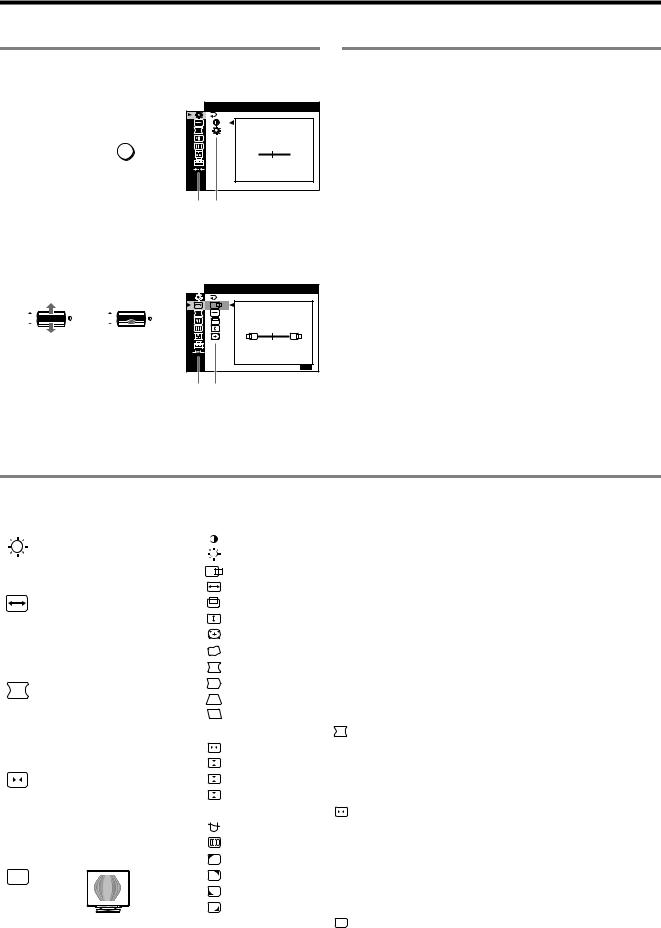
Adjustments
Navigating the menu
1 Press the MENU button to display the main menu.
|
CONTRAST / BR I GHT |
|
CONTRAST |
MENU |
, |
|
50 |
|
1 0 2 4 x 7 6 8 / 8 5 H z |
Main Sub menu menu
2 Move the control button m/M to highlight the main menu you want to adjust and press the control button.
|
|
|
S I ZE / CENTER |
OK |
, OK |
, |
|
|
|
|
45 |
|
|
|
EX I T : MENU |
|
|
Main |
Sub |
|
|
menu menu |
|
3 Select the sub menu you want to adjust and press the control button.
4 Adjust with the control button.
Adjusting the picture quality
(PICTURE EFFECT)
You can select the most appropriate picture mode from among 3 preset modes by pressing the PICTURE EFFECT button repeatedly.
x PROFESSIONAL
For accurate and consistent display color. Choose this for professional desktop publishing and graphic applications.
x STANDARD
For images with high contrast and brightness. Choose this mode for commonly used applications, such as spreadsheets, word processing, E-mail, or WEB surfing.
x DYNAMIC
For extremely vivid and photo-realistic images. Bright than “STANDARD” mode, choose this for intense entertainment software such as games, or DVD playback.
On-Screen menu adjustments
Main menu icons and adjustment |
Sub menu icons and adjustment items |
|||||||||||||||||||
items |
|
|
|
|
|
|
|
|
|
|
|
|
|
|||||||
|
|
|
|
Adjusting the contrast and |
|
|
|
|
Contrast |
|
|
|
|
|
|
|||||
|
|
|
|
brightness*1 |
|
|
|
|
|
Brightness |
|
|
|
|
|
|
||||
|
|
|
|
|
|
|
|
|
|
|
|
|
|
|
|
|
|
|
|
|
|
|
|
|
|
|
|
|
|
|
|
|
Horizontal position |
|
|
|
|
|
|
||
|
|
|
|
|
|
|
|
|
|
|
|
|
|
|
|
|
|
|
|
|
|
|
|
|
Adjusting the size or centering of |
|
|
|
|
|
Horizontal size |
|
|
|
|
|
|
||||
|
|
|
|
|
|
|
|
|
|
|
|
|
|
|
|
|
|
|||
|
|
|
|
|
|
|
|
|
Vertical position |
|
|
|
|
|
|
|||||
|
|
|
|
the picture*1 |
|
|
|
|
|
|
|
|
|
|
|
|||||
|
|
|
|
|
|
|
|
|
|
|
|
Vertical size |
|
|
|
|
|
|
||
|
|
|
|
|
|
|
|
|
|
|
|
|
|
|
|
|
|
|
|
|
|
|
|
|
|
|
|
|
|
|
|
|
Auto Size Center |
|
|
|
|
|
|
||
|
|
|
|
|
|
|
|
|
|
|
|
|
|
|
|
|
|
|
|
|
|
|
|
|
|
|
|
|
|
|
|
|
Rotating the picture |
|
|
|
|
|
|
||
|
|
|
|
|
|
|
|
|
|
|
|
|
|
|
|
|
|
|
|
|
|
|
|
|
|
|
|
|
|
|
|
|
Expanding or contracting the picture sides*1 |
||||||||
|
|
|
|
Adjusting the shape of the picture |
|
|
|
|
|
Shifting the picture sides to the left or right*1 |
||||||||||
|
|
|
|
|
|
|
|
|
Adjusting the picture width at the top of the screen*1 |
|||||||||||
|
|
|
|
|
|
|
|
|
|
|
|
|||||||||
|
|
|
|
|
|
|
|
|
|
|
|
Shifting the picture to the left or right at the top of the screen*1 |
||||||||
|
|
|
|
|
|
|
|
0 |
RESET: Returns all |
|
|
|
|
|
settings to their factory default settings. |
|||||
|
|
|
|
|
|
|
|
|
|
|
|
|
|
|
|
|
|
|
|
|
|
|
|
|
|
|
|
|
|
|
|
|
Horizontally shifts red or blue shadows |
||||||||
|
|
|
|
|
|
|
|
|
|
|
|
|||||||||
|
|
|
|
|
|
|
|
|
|
|
|
|
|
|
|
|
|
|
|
|
|
|
|
|
|
|
|
|
|
|
|
|
Vertically shifts red or blue shadows |
||||||||
|
|
|
|
|
|
|
|
|
|
|
|
|||||||||
|
|
|
|
|
|
|
|
|
|
|
|
|
|
|
|
|
|
|
|
|
|
|
|
|
Adjusting the convergence*2 |
|
|
|
T |
Vertically shifts red or blue shadows at the top of the screen |
|||||||||||
|
|
|
|
|
|
|
||||||||||||||
|
|
|
|
|
|
|
|
|
|
|
|
|
|
|
|
|
|
|
|
|
|
|
|
|
|
|
|
|
|
|
|
B |
Vertically shifts red or blue shadows at the bottom of the screen |
||||||||
|
|
|
|
|
|
|
|
|
|
|
||||||||||
|
|
|
|
|
|
|
|
|
|
|
|
|
|
|
|
|
|
|
|
|
|
|
|
|
|
|
|
|
0 |
RESET: Returns all |
|
|
|
|
|
settings to their factory default settings. |
|||||
|
|
|
|
|
|
|
|
|
|
|||||||||||
|
|
|
|
|
|
|
|
|
|
|
|
|
|
|
|
|
|
|
|
|
|
|
|
|
|
|
|
|
|
|
|
|
DEGAUSS: demagnetizes the monitor. |
||||||||
|
|
|
|
|
|
|
|
|
|
|
|
|
|
|
|
|
|
|
|
|
|
|
|
|
Adjusting the picture quality |
|
|
|
|
|
CANCEL MOIRE: adjusts the degree of moire cancellation until the moire is at a minimum.*1 |
||||||||||
|
|
|
|
Example of Moire |
|
|
|
|
LANDING: reduces any color irregularities in the screen’s top left corner to a minimum.*2 |
|||||||||||
|
|
|
|
|
|
|
|
|
|
|
|
LANDING: reduces any color irregularities in the screen’s top right corner to a minimum.*2 |
||||||||
|
|
|
|
|
|
|
|
|
|
|
|
|||||||||
|
|
|
|
|
|
|
|
|
|
|
|
|||||||||
|
|
|
|
|
|
|
|
|
|
|
|
LANDING: reduces any color irregularities in the screen’s bottom left corner to a minimum.*2 |
||||||||
|
|
|
|
|
|
|
|
|
|
|
|
LANDING: reduces any color irregularities in the screen’s bottom right corner to a minimum.*2 |
||||||||
|
|
|
|
|
|
|
|
0 |
RESET: Returns all |
|
|
|
|
|
|
|
settings to their factory default settings. |
|||
|
|
|
|
|
|
|
|
|
|
|
|
|
||||||||
|
|
|
|
|
|
|
|
|
|
|
|
|
||||||||
|
|
|
|
|
|
|
|
|
|
|
|
|
|
|
|
|
|
|
|
|
4

Main menu icons and adjustment |
Sub menu icons and adjustment items |
|||||||||||||
items |
|
|
|
|
||||||||||
|
|
|
|
|
|
|
|
|
Adjusting the color of the picture |
See “ : To adjust the color of the picture”. |
||||
|
|
|
|
|
|
|
|
|
||||||
|
|
|
|
|
|
|
|
|
|
|
|
|
|
|
|
|
|
|
|
|
|
|
|
|
|
|
|
|
|
|
|
|
|
|
|
|
|
|
|
|
|
|
Protecting adjustment data (CONTROL LOCK)*4 |
|
|
|
|
|
|
|
|
|
|
|
|
|
|
Selecting the on-screen menu language/Confirming the monitor’s information LANGUAGE/ |
|
|
|
|
|
|
|
|
|
|
Additional settings |
|
|
|
INFORMATION*3 |
|
|
|
|
|
|
|
|
|
|
|
|
|
|||
|
|
|
|
|
|
|
|
|
|
|
|
|
Changing the menu’s position for horizontal adjustment |
|
|
|
|
|
|
|
|
|
|
|
|
|
|
|
|
|
|
|
|
|
|
|
|
|
|
|
|
|
Changing the menu’s position for vertical adjustment |
|
|
|
|
|
|
|
|
|
|
|
|
|
|
||
|
|
|
|
|
|
|
|
|
|
|
|
|
||
|
|
|
|
|
|
|
|
|
|
|
|
|
|
|
|
|
|
|
|
|
|
|
|
|
|
|
|
Selecting the color adjustment mode (See “ : To adjust the color of the picture.”) |
|
|
|
|
|
|
|
|
|
|
|
|
|
|
|
|
|
|
|
|
|
|
|
|
|
Resetting the adjustments |
01*1 |
Resetting all the adjustment data for the current input signal.*5 Select “OK”. |
|||
0 |
|
|
|
|
|
|||||||||
02*2 |
Resetting all of the adjustment data for all input signals. Select “OK”. |
|||||||||||||
|
|
|
|
|
|
|
|
|
|
|||||
*1 This adjustment is effective for the current input signal. *2 This adjustment is effective for all input signals.
*3 Language Menu
• |
ENGLISH |
• |
NEDERLANDS: Dutch |
• |
FRANÇAIS: French |
• |
SVENSKA: Swedish |
•DEUTSCH: German • 


 : Russian
: Russian
•ESPAÑOL: Spanish • 
 : Japanese
: Japanese
•ITALIANO: Italian
*4 Only the ! (power) switch, EXIT, and  (CONTROL LOCK) menu will operate.
(CONTROL LOCK) menu will operate.
*5 The menu items 
 ,
,  and
and  are not reset by this method.
are not reset by this method.



 : To adjust the color of the picture
: To adjust the color of the picture
The COLOR settings allow you to adjust the picture’s color temperature by changing the color level of the white color field. Colors appear reddish if the temperature is low, and bluish if the temperature is high. This adjustment is useful for matching the monitor’s color to a printed picture’s colors.
Select one of the color temperature setting modes from among
4 modes; EASY, PRESET, EXPERT, and sRGB on  (OPTION) menu.
(OPTION) menu.
x EASY (Default setting)
You can adjust the color temperature from 5000K to 11000K.
x PRESET
You can select the preset color temperature from 5000K, 6500K, or 9300K. The default setting is 9300K.
x EXPERT
You can make additional fine adjustments to the color by selecting this mode. GAIN ( ) adjusts the bright areas of the screen, while BIAS (
) adjusts the bright areas of the screen, while BIAS (  ) adjusts the dark areas of the screen.
) adjusts the dark areas of the screen.
Select |
for |
|
Select |
for |
R |
R (Red) BIAS |
|
R |
R (Red) GAIN |
|
|
|
|
|
G |
G (Green) |
|
G |
G (Green) GAIN |
BIAS |
|
|||
|
|
|
|
|
|
|
|
|
|
B |
B (Blue) BIAS |
|
B |
B (Blue) GAIN |
0RESET
x sRGB
The sRGB color setting is an industry standard color space protocol designed to correlate the colors displayed on the monitor and those printed. In order to display the sRGB colors correctly (γ = 2.2, 6500K), select the sRGB mode and set the PROFESSIONAL mode of PICTURE EFFECT (page 4) and your connected computer to the sRGB profile. If you select sRGB, you cannot operate the CONTRAST/BRIGHT menu adjustments.
To restore the color from the EASY, PRESET, or sRGB modes (  IMAGE RESTORATION)
IMAGE RESTORATION)
You can restore the color to the original factory quality levels. Before using this feature, the monitor must have been in normal operation mode (green power indicator on) for at least 30 minutes. You may need to adjust your computer’s power saving settings. If the monitor has not been on for at least 30 minutes, the “AVAILABLE AFTER WARM UP” message will appear. Also, this function may gradually lose its effectiveness due to the natural
aging of the Trinitron picture tube.
GB
5

Troubleshooting
x No picture
If the ! (power) indicator is not lit
•Check that the power cord is properly connected.
•Check that the ! (power) switch is in the “on” position.
The ! (power) indicator is orange
•Check that the video signal cable is properly connected and all plugs are firmly seated in their sockets.
•Check that the INPUT switch setting is correct.
•Check that the HD15 video input connector’s pins are not bent or pushed in.
•Check that the computer’s power is “on”.
•The computer is in power saving mode. Try pressing any key on the computer keyboard or moving the mouse.
•Check that the graphic board is completely seated in the proper bus slot.
If the ! (power) indicator is green or flashing orange
• Use the Self-diagnosis function.
x Picture flickers, bounces, oscillates, or is scrambled
•Isolate and eliminate any potential sources of electric or magnetic fields such as other monitors, laser printers, electric fans, fluorescent lighting, or televisions.
•Move the monitor away from power lines or place a magnetic shield near the monitor.
•Try plugging the monitor into a different AC outlet, preferably on a different circuit.
•Try turning the monitor 90° to the left or right.
•Check your graphics board manual for the proper monitor setting.
•Confirm that the graphics mode and the frequency of the input signal are supported by this monitor (see “Preset mode timing table” on page i). Even if the frequency is within the proper range, some graphics board may have a sync pulse that is too narrow for the monitor to sync correctly.
•Adjust the computer’s refresh rate (vertical frequency) to obtain the best possible picture.
x Picture is fuzzy
•Adjust the contrast, brightness, and PICTURE EFFECT.
•Degauss the monitor.*
•Adjust the degree of moire cancellation until the moire is minimal, or set CANCEL MOIRE to OFF.
x Picture is ghosting
•Eliminate the use of video cable extensions and/or video switch boxes.
•Check that all plugs are firmly seated in their sockets.
x Picture is not centered or sized properly
•Perform the Auto Size Center function.
•Adjust the size or centering. Note that with some input signals and/ or graphics board the periphery of the screen is not fully utilized.
•Just after turning on the power switch, the size/center may take a while to adjust properly.
xEdges of the image are curved
• Adjust the geometry.
xWavy or elliptical pattern (moire) is visible
•Adjust the degree of moire cancellation until the moire is minimal.
•Change your desktop pattern.
x Color is not uniform
•Degauss the monitor.* If you place equipment that generates a magnetic field, such as a speaker, near the monitor, or if you change the direction the monitor faces, color may lose uniformity.
•Adjust the landing.
x White does not look white
•Adjust the color temperature.
•Check that the 5 BNC connectors are connected in the correct order.
xMonitor buttons do not operate (  appears on the screen)
appears on the screen)
• If the control lock is set to ON, set it to OFF.
xLetters and lines show red or blue shadows at the edges
• Adjust the convergence.
x USB peripherals do not function
•Check that the appropriate USB connectors are securely connected.
•Turn the monitor OFF and then ON again, then reconnect USB cable.
•If you connect a keyboard or mouse to the USB connectors and then boot your computer for the first time, the peripheral devices may not function. First connect the keyboard and mouse directly to the computer and set up the USB compliant devices. Then connect them to this monitor.
•Install the latest version of the device driver on your computer. Contact your device’s manufacturer for information about the appropriate device driver.
x A hum is heard right after the power is turned on
• This is the sound of the auto-degauss cycle. When the power is turned on, the monitor is automatically degaussed for a few seconds.
*If a second degauss cycle is needed, allow a minimum interval of
20 minutes for the best result. A humming noise may be heard, but this is not a malfunction.
On-screen messages
|
|
I NFORMAT I ON |
|
|
|
|
|||
|
|
MON I TOR |
I |
S |
WORK I NG |
|
|
|
|
|
|
I NPUT |
2 |
: |
NO |
S I GNAL |
|
W |
|
|
|
ACT I VATE |
|
BY |
COMPUTER |
|
|
||
|
|
CHECK |
S I GNAL |
CABLE |
R |
|
|||
|
|
|
|||||||
|
|
CHECK |
I NPUT |
SELECTOR |
G |
|
|||
|
|
|
|
|
|
|
|
B |
|
1 If “NO SIGNAL” appears:
This indicates that no signal is input from the selected connector. 2 Shows the currently selected connector.
3 Shows the remedies.
•If ACTIVATE BY COMPUTER appears on the screen, try pressing any key on the computer or moving the mouse, and confirm that your computer’s graphic board is completely seated in the correct bus slot.
•If CHECK SIGNAL CABLE appears on the screen, check that the monitor is correctly connected to the computer.
•If CHECK INPUT SELECTOR appears on the screen, try changing the input signal.
|
I NFORMAT I ON |
|
|
||
|
MONI TOR |
I S WORK I NG |
|
|
|
|
I NPUT |
1 : 2 0 0 . 0 k H z / 85Hz |
|
|
|
|
|
W |
|
||
|
OUT OF |
SCAN RANGE |
|
|
|
|
CHANGE |
S I GNAL T I M I NG |
R |
|
|
|
G |
|
|||
|
|
|
|
B |
|
1 If “OUT OF SCAN RANGE” appears:
This indicates that the input signal is not supported by the monitor’s specifications.
2 Shows the input signal frequency.
3 Shows the remedies.
CHANGE SIGNAL TIMING appears on the screen. If you are replacing an old monitor with this monitor, reconnect the old monitor. Then adjust the computer’s graphic board so that the horizontal frequency is between 30 – 137 kHz (GDM-F520),
30 – 115 kHz (GDM-F420), and the vertical frequency is between 48 – 170 Hz.
6
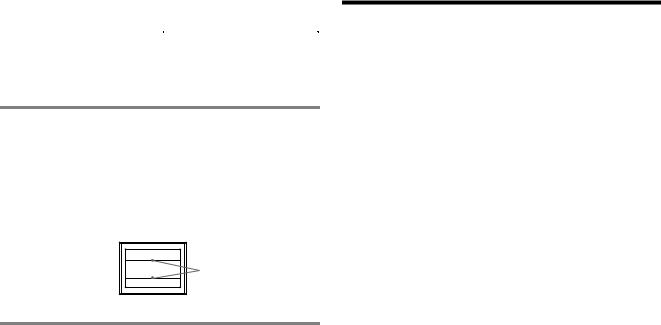
To display this monitor’s name, serial number, and date of manufacture.
While the monitor is receiving a |
|
|
|||
INFORMATION |
|
||||
video signal, press and hold the |
|
|
|
|
|
MENU button for more than |
MODEL : GDM |
|
F520 |
W |
|
|
|||||
5 seconds to display this |
SER NO : 1234567 |
R |
|||
G |
|||||
monitor’s information box. |
MANUFACTURED : 2000-52 |
||||
B |
|||||
|
|
|
|||
If thin lines appear on the screen
(damper wires)
These lines do not indicate a malfunction; they are a normal effect of the Trinitron picture tube with this monitor. These are shadows from the damper wires used to stabilize the aperture grille. The aperture grille is the essential element that makes a Trinitron picture tube unique by allowing more light to reach the screen, resulting in a brighter, more detailed picture.
Damper wires
Self-diagnosis function
This monitor is equipped with a self-diagnosis function. If there is a problem with your monitor or computer(s), the screen will go blank and the ! (power) indicator will either light up green or flash orange. If the ! (power) indicator is lit in orange, the computer is in power saving mode. Try pressing any key on the keyboard or moving the mouse.
x If the ! (power) indicator is green
1 Disconnect any plugs from the video input 1 and 2 connectors, or turn off the connected computer(s).
2 Turn the monitor OFF and then ON.
3 Hold the control button upward for a few seconds before the monitor enters power saving mode.
If all 4 color bars appear (white, red, green, blue), the monitor is working properly. Reconnect the video input cables and check the condition of your computer(s).
If the color bars do not appear, there is a potential monitor failure. Inform your authorized Sony dealer of the monitor’s condition.
x If the ! (power) indicator is flashing orange
Turn the monitor OFF and then ON.
If the ! (power) indicator lights up green, the monitor is working properly.
If the ! (power) indicator is still flashing, there is a potential monitor failure. Count the number of seconds between orange flashes of the ! (power) indicator and inform your authorized Sony dealer of the monitor’s condition. Be sure to note the model name and serial number of your monitor. Also note the make and model of your computer and graphics board.
Specifications
CRT |
|
|
0.22 mm aperture grille pitch, 90-degree deflection, FD Trinitron |
|
|
GDM-F520 |
21 inches measured diagonally |
|
GDM-F420 |
19 inches measured diagonally |
|
Viewable image size |
|
|
GDM-F520 |
Approx. 403.8 × 302.2 mm (w/h) (16 × 12 inches) |
|
|
19.8" viewing image |
|
GDM-F420 |
Approx. 365 × 274 mm (w/h) (14 3/8 × 10 7/8 inches) |
|
|
18.0" viewing image |
|
Resolution (H:Horizontal, V:Vertical) |
|
|
GDM-F520 |
Maximum: H: 2048 dots, V: 1536 lines |
|
|
Recommended: H: 1600 dots, V: 1200 lines |
|
GDM-F420 |
Maximum: H: 1920 dots, V: 1440 lines |
|
|
Recommended: H: 1280 dots, V: 1024 lines |
|
Input signal levels |
Analog RGB: 0.700 Vp-p (positive), 75 Ω |
|
Video signal: |
|
|
SYNC signal: |
H/V separate or composite sync: |
|
|
TTL 2 kΩ, Polarity free |
|
|
Sync on Green: 0.3 Vp-p (negative) |
|
Standard image area |
Approx. 388 × 291 mm (4:3) |
|
GDM-F520 |
|
|
|
(15 3/8 × 11 1/2 inches) or |
|
|
Approx. 364 × 291 mm (5:4) |
|
|
(14 3/8 × 11 1/2 inches) |
|
GDM-F420 |
Approx. 352 × 264 mm (4:3) |
|
|
(13 7/8 × 10 1/2 inches) or |
|
|
Approx. 330 × 264 mm (5:4) |
|
|
(13 × 10 1/2 inches) |
|
Deflection frequency (H:Horizontal, V:Vertical) |
|
|
GDM-F520 |
H: 30 to 137 kHz, V: 48 to 170 Hz |
GB |
GDM-F420 |
H: 30 to 115 kHz, V: 48 to 170 Hz |
|
AC input voltage/current |
|
|
|
100 to 240 V, 50 – 60 Hz, 2.0 – 1.0 A |
|
Power Consumption (with no USB devices connected) |
|
|
GDM-F520 |
Approx. 145 W |
|
GDM-F420 |
Approx. 135 W |
|
Operating temperature |
|
|
|
10 ºC to 40 ºC |
|
Dimensions |
Approx. 497 × 499 × 487 mm (w/h/d) |
|
GDM-F520 |
|
|
|
(19 5/8 × 19 3/4 × 19 1/4 inches) |
|
GDM-F420 |
Approx. 446 × 472 × 463 mm (w/h/d) |
|
Mass |
(17 5/8 × 18 5/8 × 18 1/4 inches) |
|
|
|
|
GDM-F520 |
Approx. 30 kg (66 lb 2 oz) |
|
GDM-F420 |
Approx. 26 kg (57 lb 5 oz) |
|
Plug and Play |
DDC2B/DDC2Bi |
|
Supplied accessories
Power cord
HD15 video signal cable
USB cable
Exclusive Power Mac G3/G4 adapter
This instruction manual
(continued)
7
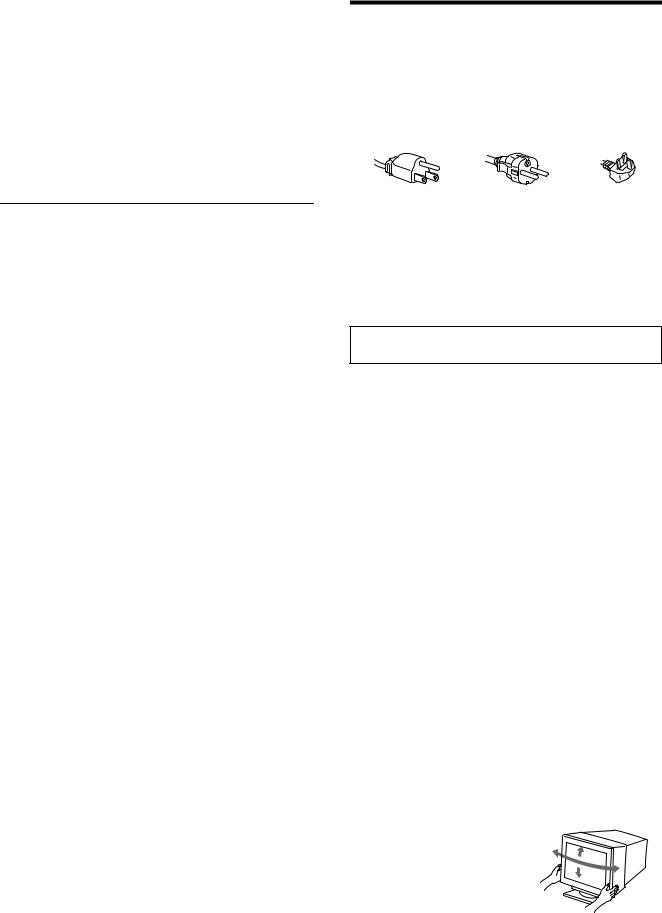
Preset and user modes
When the monitor receives an input signal, it automatically matches the signal to one of the factory preset modes stored in the monitor’s memory to provide a high quality picture (see “Preset mode timing table” on page i). If the input signals does not match one of the factory preset modes, the monitor automatically provides the most appropriate picture for the input signal that is within the range of the vertical or horizontal frequencies (page 7) corresponding to the Generalized Timing Formula. When the picture is adjusted, the adjustment data is stored as a user mode and automatically recalled whenever the same input signal is received.
Power saving function
This monitor meets the power-saving guidelines set by VESA, TCO’99, and ENERGY STAR. If no signal is input to the monitor from your computer, the monitor will automatically reduce power consumption as shown below.
Power mode |
Power consumption*1 |
! (power) |
|
|
indicator |
|
|
|
normal operation |
≤ 145 W (GDM-F520) |
green |
|
≤ 135 W (GDM-F420) |
|
active off*2 |
≤ 3 W |
orange |
(deep sleep)*3 |
|
|
*1 Figures reflect power consumption when no USB compatible peripherals are connected to the monitor.
*2 When your computer enters power saving mode, NO SIGNAL appears on the screen. After a few seconds, the monitor enters power saving mode.
*3 “Deep sleep” is power saving mode defined by the Environmental Protection Agency.
Design and specifications are subject to change without notice.
Precautions
Warning on power connections
•Use the supplied power cord. If you use a different power cord, be sure that it is compatible with your local power supply.
For the customers in the UK
If you use the monitor in the UK, be sure to use the supplied UK power cable.
Example of plug types
for 100 to 120 V AC |
for 200 to 240 V AC for 240 V AC only |
•Before disconnecting the power cord, wait at least 30 seconds after turning off the power to allow the static electricity on the screen’s surface to discharge.
•After the power is turned on, the screen is demagnetized (degaussed) for about a few seconds. This generates a strong magnetic field around the screen which may affect data stored on magnetic tapes and disks placed near the monitor. Be sure to keep magnetic recording equipment, tapes, and disks away from the monitor.
The equipment should be installed near an easily accessible outlet.
Installation
Do not install the monitor in the following places:
•on surfaces (rugs, blankets, etc.) or near materials (curtains, draperies, etc.) that may block the ventilation holes
•near heat sources such as radiators or air ducts, or in a place subject to direct sunlight
•in a place subject to severe temperature changes
•in a place subject to mechanical vibration or shock
•on an unstable surface
•near equipment which generates magnetism, such as a transformer or high voltage power lines
•near or on an electrically charged metal surface
•inside an enclosed rack
Maintenance
•Clean the screen with a soft cloth. If you use a glass cleaning liquid, do not use any type of cleaner containing an anti-static solution or similar additive as this may scratch the screen’s coating.
•Do not rub, touch, or tap the surface of the screen with sharp or abrasive items such as a ballpoint pen or screwdriver. This type of contact may result in a scratched picture tube.
•Clean the cabinet, panel and controls with a soft cloth lightly moistened with a mild detergent solution. Do not use any type of abrasive pad, scouring powder or solvent, such as alcohol or benzine.
Transportation
When you transport this monitor for repair or shipment, use the original carton and packing materials.
Display Stand
Do not remove this monitor’s stand.
Use of the tilt-swivel |
|
|
|
This monitor can be adjusted |
|
|
|
within the angles shown right. To |
90° |
15° |
|
turn the monitor vertically or |
|
90° |
|
|
|
||
horizontally, hold it at the bottom |
|
5° |
|
with both hands. |
|
|
|
8
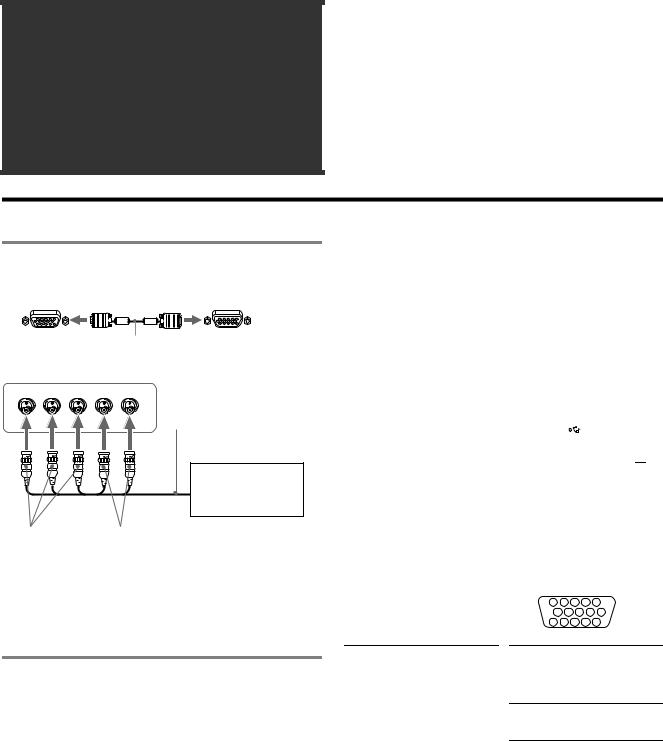
Table des Matières
Configuration . . . . . . . . . . . . . . . . . . . . . . . . . . . . . . . 3 Réglages. . . . . . . . . . . . . . . . . . . . . . . . . . . . . . . . . . . 4 Dépannage . . . . . . . . . . . . . . . . . . . . . . . . . . . . . . . . . 6 Spécifications . . . . . . . . . . . . . . . . . . . . . . . . . . . . . . 7 Précautions . . . . . . . . . . . . . . . . . . . . . . . . . . . . . . . . 8 Appendix . . . . . . . . . . . . . . . . . . . . . . . . . . . . . . . . . . . i
Preset mode timing table . . . . . . . . . . . . . . . . . . . . . . . i TCO’99 Eco-document. . . . . . . . . . . . . .Couverture dos
•Trinitronâ est une marque commerciale déposée de Sony Corporation.
•Macintosh est une marque commerciale sous licence d’Apple Computer, Inc., déposée aux Etats-Unis et dans d’autres pays.
•Windowsâ et MS-DOS sont des marques déposées de Microsoft Corporation aux Etats-Unis et dans d’autres pays.
•IBM PC/AT et VGA sont des marques commerciales déposées d’IBM Corporation aux Etats-Unis.
•VESA et DDCä sont des marques commerciales de Video Electronics Standard Association.
•ENERGY STAR est une marque déposée aux Etats-Unis.
•Tous les autres noms de produits mentionnés dans le présent mode d’emploi peuvent être des marques commerciales ou des marques commerciales déposées de leurs sociétés respectives.
•Les symboles “ä” et “â” ne sont pas mentionnés systématiquement dans le présent mode d’emploi.
Configuration
1Raccordez votre moniteur à votre ordinateur
x Raccordement au connecteur d’entrée HD15
vers le HD15 |
câble de signal |
vers le HD15 de |
|
vidéo (fourni) |
l’ordinateur raccordé |
x Raccordement aux 5 connecteurs BNC
R G B HD VD
câble de signal vidéo (non fourni)
Reportez-vous aux exemples précédents pour raccorder l’ordinateur.
vers VIDEO IN R/G/B vers SYNC IN HD/VD
Raccordement à un Macintosh ou un ordinateur compatible
Lorsque vous connectez ce moniteur à un Power Mac G3/G4, utilisez l’adaptateur fourni, le cas échéant. Raccordez l’adaptateur fourni à l’ordinateur avant de raccorder le câble. Si vous possédez un autre type d’ordinateur Macintosh, doté de 2 rangées de broches, vous devrez utiliser un adaptateur différent (non fourni).
2Mettez le moniteur et l’ordinateur sous tension
1 Raccordez le cordon d’alimentation au moniteur puis appuyez sur l’interrupteur ! (alimentation) afin de mettre le moniteur sous tension.
2 Mettez l’ordinateur sous tension.
Vous n’avez pas besoin de pilotes spécifiques
Ce moniteur est conforme à la norme Plug & Play “DDC” et détecte automatiquement l’ensemble des informations relatives au moniteur. Il n’est pas nécessaire d’installer un pilote ou un gestionnaire supplémentaire sur l’ordinateur.
Lorsque vous mettez votre ordinateur sous tension pour la première fois, après l’avoir raccordé au moniteur, il est possible que l’Assistant d’ajout de nouveau matériel apparaisse à l’écran. Dans ce cas, suivez les instructions affichées. Le moniteur Plug & Play approprié est sélectionné automatiquement, vous permettant ainsi de l’utiliser.
Remarques
•Plug and Play ne s’applique qu’au connecteur HD15 et non aux 5 connecteurs BNC.
•Ne touchez pas les broches du connecteur du câble de signal vidéo.
•Vérifiez l’alignement du connecteur HD15 pour ne pas tordre les broches du connecteur du câble de signal vidéo.
Sélection du signal d’entrée
Vous pouvez raccorder deux ordinateurs à ce moniteur à l’aide des connecteurs HD15 et BNC. Pour basculer d’un ordinateur à l’autre, utilisez le commutateur INPUT. Le connecteur sélectionné apparaît à l’écran pendant 3 secondes.
Remarque
Si aucun signal n’est entré par le connecteur sélectionné, le message PAS DE VIDEO apparaît à l’écran. Après quelques secondes, le moniteur passe en mode d’économie d’énergie. Si tel est le cas, basculez sur l’autre connecteur.
Raccordement de périphériques compatibles USB (bus série universel)
Assurez-vous que le moniteur et l’ordinateur sont sous tension puis |
|
|||
raccordez votre ordinateur aux connecteurs USB ( |
|
) situés sur le côté |
FR |
|
|
||||
droit du moniteur. |
||||
|
||||
Raccordez votre ordinateur au connecteur d’envoi carré (  ) à l’aide du câble USB fourni.
) à l’aide du câble USB fourni.
Si un message Windows s’affiche, suivez les instructions à l’écran et sélectionnez “Concentrateur USB générique”.
Raccordez le connecteur USB rectangulaire de réception ( ) lorsque vous raccordez vos périphériques compatibles USB (par exemple, une imprimante, le clavier, la souris, un scanner, etc.).
) lorsque vous raccordez vos périphériques compatibles USB (par exemple, une imprimante, le clavier, la souris, un scanner, etc.).
Remarque
Le moniteur fonctionne comme un concentrateur USB tant qu’il est allumé ou en mode d’économie d’énergie.
Connecteurs d’entrée HD15
5 4 3 2 1
10 9 8 7 6
15 14 13 12 11
N° de broche |
Signal |
1 |
Rouge |
|
|
2 |
Vert |
|
(Sync sur Vert) |
|
|
3 |
Bleu |
|
|
4 |
ID (Masse) |
|
|
5 |
DDC (Masse)* |
|
|
6 |
Masse Rouge |
|
|
7 |
Masse Vert |
|
|
8 |
Masse Bleu |
N° de broche |
Signal |
9 |
DDC + 5V* |
|
|
10 |
Masse |
|
|
11 |
ID (Masse) |
12Données bi-directionnelles (SDA)*
13 |
Sync H |
14 |
Sync V |
|
|
15 |
Horloge de |
|
données (SCL)* |
* DDC (Display Data Channel) est une norme de VESA.
3
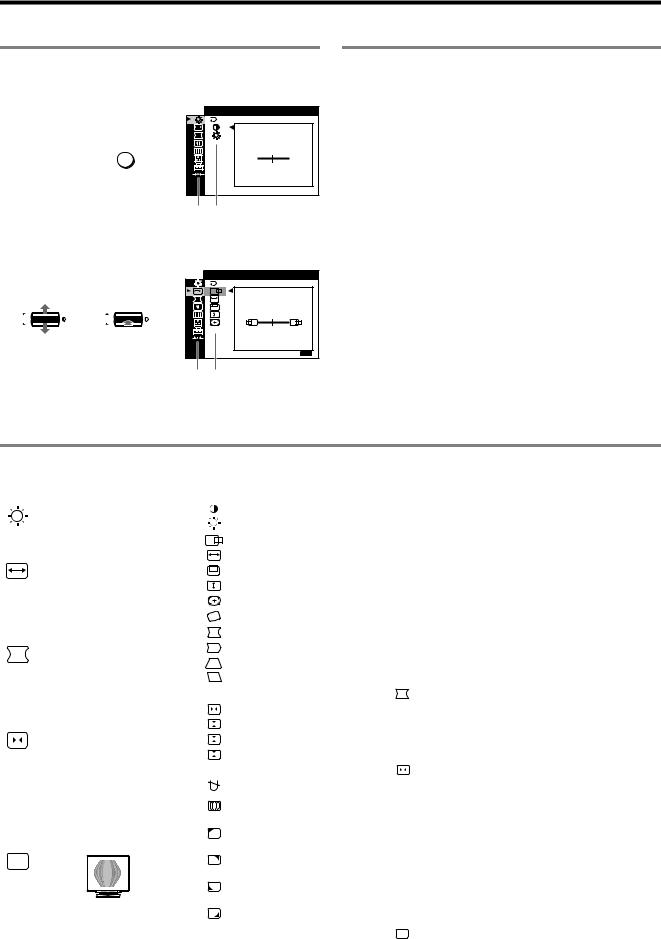
Réglages
Navigation dans le menu
1 Appuyez sur la touche MENU pour afficher le menu principal.
|
CONTR / LUM I N |
|
CONTRASTE |
MENU |
, |
|
50 |
|
1 0 2 4 x 7 6 8 / 8 5 H z |
Menu principal Sous-menu
2Déplacez la touche de commande m/M pour mettre en surbrillance le menu principal que vous souhaitez régler et appuyez sur la touche de commande.
|
|
T A I LL / CENTRAGE |
OK |
, OK |
, |
|
|
45 |
|
|
SORT I R : MENU |
Menu principal Sous-menu
3Sélectionnez le sous-menu que vous souhaitez régler puis appuyez sur la touche de commande.
4Effectuez le réglage à l’aide de la touche de commande.
Réglage de la qualité de l’image
(PICTURE EFFECT)
Vous pouvez sélectionner le mode d’image le plus approprié parmi 3 modes prédéfinis, en appuyant sur la touche PICTURE EFFECT de façon répétée.
x PROFESSIONNEL
Pour un affichage et des couleurs précises et homogènes. Choisissez cette option si vous utilisez des applications graphiques et de retouche d’images.
x STANDARD
Pour des images avec un haut niveau de contraste et de luminosité. Choisissez ce mode pour la plupart des applications courantes, comme les traitements de texte, les tableurs, la messagerie électronique ou la navigation sur le Web.
x DYNAMIQUE
Pour des images éclatantes de réalisme. Utilisez ce mode, offrant une meilleure restitution que le mode “STANDARD”, pour des utilisations graphiques poussées telles que des jeux ou une lecture DVD.
Réglages du menu d’écran
Icônes du menu principal et éléments |
Icônes du sous-menu et éléments de réglage |
|
|||||||||||||||||||
de réglage |
|
|
|
|
|
|
|
|
|
|
|
|
|
|
|
||||||
|
|
|
|
|
|
|
|
|
|
|
|
|
|
|
|
|
|
|
|
|
|
|
|
|
|
Réglage du contraste et de la |
|
|
|
|
Contraste |
|
|||||||||||
|
|
|
|
luminosité*1 |
|
|
|
|
Luminosité |
|
|||||||||||
|
|
|
|
|
|
|
|
|
|
|
Position horizontale |
|
|||||||||
|
|
|
|
|
|
|
|
|
|
|
|
|
|
|
|
|
|
|
|
|
|
|
|
|
|
Réglage de la taille ou du centrage |
|
|
|
|
Taille horizontale |
|
|||||||||||
|
|
|
|
|
|
|
|
|
|
|
|
|
|
|
|
|
|
|
|||
|
|
|
|
|
|
|
|
Position verticale |
|
||||||||||||
|
|
|
|
de l’image*1 |
|
|
|
|
|
||||||||||||
|
|
|
|
|
|
|
|
Taille verticale |
|
||||||||||||
|
|
|
|
|
|
|
|
|
|
|
|
||||||||||
|
|
|
|
|
|
|
|
|
|
|
|
|
|
|
|
|
|
|
|
|
|
|
|
|
|
|
|
|
|
|
|
|
Centrage de taille automatique |
|
|||||||||
|
|
|
|
|
|
|
|
|
|
|
|
|
|
|
|
|
|
|
|
|
|
|
|
|
|
|
|
|
|
|
|
|
Rotation de l’image |
|
|||||||||
|
|
|
|
|
|
|
|
|
|
|
|
|
|
|
|
|
|
|
|
|
|
|
|
|
|
|
|
|
|
|
|
|
Étirement ou contraction des côtés de l’image*1 |
||||||||||
|
|
|
|
Réglage de la forme de l’image |
|
|
|
|
Déplacement des bords de l’image vers la droite ou la gauche*1 |
||||||||||||
|
|
|
|
|
|
|
|
Réglage de la largeur de l’image en haut de l’écran*1 |
|||||||||||||
|
|
|
|
|
|
|
|
|
|
|
|||||||||||
|
|
|
|
|
|
|
|
|
|
|
Déplacement de l’image vers la droite ou la gauche en haut de l’écran*1 |
||||||||||
|
|
|
|
|
|
|
0 |
REINITIALISATION : Les réglages |
sont tous réinitialisés sur les valeurs par défaut. |
||||||||||||
|
|
|
|
|
|
|
|
|
|
|
|
|
|
|
|
|
|
|
|
|
|
|
|
|
|
|
|
|
|
|
|
|
Décalage horizontal des ombres rouges ou bleues |
||||||||||
|
|
|
|
|
|
|
|
|
|
|
|||||||||||
|
|
|
|
|
|
|
|
|
|
|
|
|
|
|
|
|
|
|
|
|
|
|
|
|
|
Réglage de la convergence*2 |
|
|
|
|
Décalage vertical des ombres rouges ou bleues |
||||||||||||
|
|
|
|
|
|
|
|
||||||||||||||
|
|
|
|
|
|
|
|
|
|
|
|
|
|
|
|
|
|
|
|||
|
|
|
|
|
|
|
T |
Décalage vertical des ombres rouges ou bleues en haut de l’écran |
|||||||||||||
|
|
|
|
|
|
|
|||||||||||||||
|
|
|
|
|
|
|
|
|
|
|
|
|
|
|
|
|
|
|
|
|
|
|
|
|
|
|
|
|
|
|
|
B |
Décalage horizontal des ombres rouges ou bleues en bas de l’écran |
||||||||||
|
|
|
|
|
|
|
|
|
|
||||||||||||
|
|
|
|
|
|
|
|
|
|
|
|
|
|
|
|
|
|
|
|
|
|
|
|
|
|
|
|
|
0 |
REINITIALISATION : Les réglages |
|
|
|
|
|
|
sont tous réinitialisés sur les valeurs par défaut. |
||||||
|
|
|
|
|
|
|
|
|
|
||||||||||||
|
|
|
|
|
|
|
|
|
|
|
|
|
|
|
|
|
|
|
|
|
|
|
|
|
|
|
|
|
|
|
|
|
DEMAGNET : démagnétise le moniteur. |
|
|||||||||
|
|
|
|
|
|
|
|
|
|
|
|
|
|
|
|
|
|
|
|
|
|
|
|
|
|
|
|
|
|
|
|
|
SUPPRESSION MOIRAGE : règle le degré de suppression du moiré afin de réduire le moiré au |
||||||||||
|
|
|
|
|
|
|
|
|
|
|
minimum.*1 |
|
|||||||||
|
|
|
|
Réglage de la qualité de l’image |
|
|
|
|
PURETE COULEUR : réduit au minimum les irrégularités des couleurs dans l’angle supérieur gauche |
||||||||||||
|
|
|
|
Exemple de moiré |
|
|
|
|
de l’écran.*2 |
|
|||||||||||
|
|
|
|
|
|
|
|
PURETE COULEUR : réduit au minimum les irrégularités des couleurs dans l’angle supérieur droit de |
|||||||||||||
|
|
|
|
|
|
|
|
|
|
|
|||||||||||
|
|
|
|
|
|
|
|
|
|
|
l’écran.*2 |
|
|||||||||
|
|
|
|
|
|
|
|
|
|
|
|
||||||||||
|
|
|
|
|
|
|
|
|
|
|
PURETE COULEUR : réduit au minimum les irrégularités des couleurs dans l’angle inférieur gauche |
||||||||||
|
|
|
|
|
|
|
|
|
|
|
de l’écran.*2 |
|
|||||||||
|
|
|
|
|
|
|
|
|
|
|
PURETE COULEUR : réduit au minimum les irrégularités des couleurs dans l’angle inférieur droit de |
||||||||||
|
|
|
|
|
|
|
|
|
|
|
l’écran.*2 |
|
|||||||||
|
|
|
|
|
|
|
0 |
REINITIALISATION : Les réglages |
|
|
|
|
|
sont tous réinitialisés sur les valeurs par défaut. |
|||||||
|
|
|
|
|
|
|
|
|
|
||||||||||||
|
|
|
|
|
|
|
|
|
|
||||||||||||
|
|
|
|
|
|
|
|
|
|
|
|
|
|
|
|
|
|
|
|
|
|
4
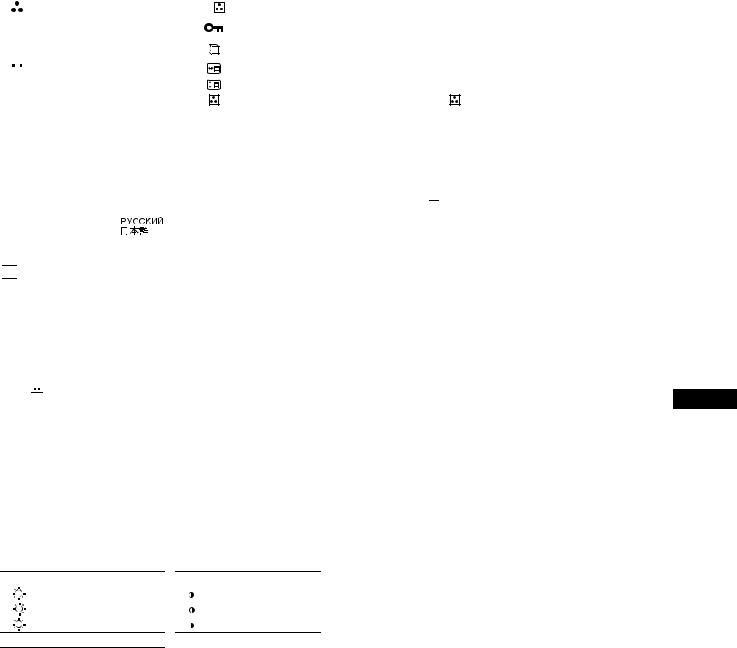
Icônes du menu principal et éléments |
Icônes du sous-menu et éléments de réglage |
|
|||||||||||||
de réglage |
|
|
|
|
|
||||||||||
|
|
|
|
|
|
|
|
|
Réglage de la couleur de l’image |
Voir “ : pour régler la couleur de l’image”. |
|
||||
|
|
|
|
|
|
|
|
|
|
||||||
|
|
|
|
|
|
|
|
|
|
|
|
|
|
|
|
|
|
|
|
|
|
|
|
|
|
|
|
|
|
|
|
|
|
|
|
|
|
|
|
|
|
|
|
|
Protection des données de réglage (VERROU MENU)*4 |
|
|
|
|
|
|
|
|
|
|
|
|
|
|
|
Sélection de la langue d’affichage à l’écran/Confirmation des informations relatives au moniteur |
||
|
|
|
|
|
|
|
|
|
Réglages supplémentaires |
|
|
|
LANGUAGE/INFORMATIONS*3 |
|
|
|
|
|
|
|
|
|
|
|
|
|
|
|
|||
|
|
|
|
|
|
|
|
|
|
|
|
|
Modification de la position du menu pour le réglage horizontal |
|
|
|
|
|
|
|
|
|
|
|
|
|
|
|
|
|
|
|
|
|
|
|
|
|
|
|
|
|
|
|
Modification de la position du menu pour le réglage vertical |
|
|
|
|
|
|
|
|
|
|
|
|
|
|
|
|
||
|
|
|
|
|
|
|
|
|
|
|
|
|
|
||
|
|
|
|
|
|
|
|
|
|
|
|
|
|
||
|
|
|
|
|
|
|
|
|
|
|
|
|
Sélection du mode de réglage des couleurs. (Voir “ : Pour régler la couleur de l’image”.) |
||
|
|
|
|
|
|
|
|
|
|
|
|
|
|
|
|
|
|
|
|
|
|
|
|
|
|
01*1 |
Réinitialisation de l’ensemble des données de réglage pour le signal d’entrée actuel.*5 |
Appuyez sur |
|||
|
|
|
|
|
|
|
|
|
|
“OK”. |
|
||||
|
|
|
|
|
|
|
|
|
Réinitialisation des réglages |
|
|
|
|
||
0 |
|
|
|
|
|
|
|||||||||
02*2 |
Réinitialisation de l’ensemble des données de réglage pour tous les signaux d’entrée. Appuyez sur |
||||||||||||||
|
|
|
|
|
|
|
|
|
|
||||||
|
|
|
|
|
|
|
|
|
|
“OK”. |
|
||||
|
|
|
|
|
|
|
|
|
|
|
|
|
|
||
|
|
|
|
|
|
|
|
|
|
|
|
|
|
|
|
*1 Ce réglage est effectif pour le signal d’entrée courant.
*2 Ce réglage est effectif pour tous les autres signaux d’entrée. *3 Menu de langues
• |
ENGLISH : Anglais |
• NEDERLANDS : Néerlandais |
|
• |
FRANÇAIS |
• SVENSKA : Suédois |
|
• |
DEUTSCH : Allemand |
• |
: Russe |
• |
ESPAÑOL : Espagnol |
• |
: Japonais |
• |
ITALIANO : Italien |
|
|
*4 Seul le commutateur (d’alimentation) !, SORTIR et  (VERROU MENU) fonctionnent.
(VERROU MENU) fonctionnent.
*5 Les options de menu 
 ,
,  et
et  ne sont pas réinitialisées par cette méthode.
ne sont pas réinitialisées par cette méthode.



 : pour régler la couleur de l’image
: pour régler la couleur de l’image
Les paramètres COULEUR permettent de régler la température des couleurs de l’image en changeant le niveau de couleur des champs de couleur blanche. Les couleurs apparaissent rougeâtres lorsque la température est basse et bleuâtres lorsqu’elle est élevée. Ce réglage s’avère pratique pour faire correspondre les couleurs du moniteur aux couleurs d’une image imprimée.
Sélectionnez l’un des modes de réglage de température des couleurs parmi les 4 modes; SIMPLE, PRESELECT, EXPERT et sRGB dans le menu 



 (OPTION).
(OPTION).
x SIMPLE (Réglage par défaut)
Vous pouvez régler la température des couleurs sur une plage comprise entre 5000K et 11000K.
x PRESELECT
Vous pouvez sélectionner une température des couleurs prédéfinie, à savoir 5000K, 6500K, ou 9300K. Le réglage par défaut est 9300K.
x EXPERT
Vous pouvez effectuer des réglages affinés supplémentaires des couleurs en sélectionnant ce mode. GAIN (  ) règle les zones lumineuses de l’écran, alors que BIAS (
) règle les zones lumineuses de l’écran, alors que BIAS (  ) règle les zones sombres.
) règle les zones sombres.
Sélectionnez |
pour |
|
Sélectionnez |
pour |
R |
R (Rouge) BIAS |
|
R |
R (Rouge) GAIN |
|
|
|
|
|
G |
G (Vert) BIAS |
|
G |
G (Vert) GAIN |
|
|
|
|
|
B |
B (Bleu) BIAS |
|
B |
B (Bleu) GAIN |
0REINITIALISATION
x sRGB
Le réglage de couleur sRGB est un protocole industriel standard pour les espaces colorimétriques. Il est conçu pour harmoniser les couleurs affichées sur le moniteur et les couleurs imprimées. Pour afficher les couleurs sRGB correctement (γ = 2,2, 6500K), sélectionnez le mode sRGB, réglez le mode PICTURE EFFECT sur PROFESSIONNEL (page 4) puis réglez l’ordinateur raccordé sur le profil sRGB. Il est impossible d’utiliser les réglages du menu CONTR/LUMIN. lorsque vous sélectionnez le mode sRGB.
Restauration des couleurs via les modes SIMPLE, PRESELECT ou sRGB (  RESTAURER COULEUR)
RESTAURER COULEUR)
Vous pouvez restaurer les couleurs par défaut, afin de retrouver les niveaux de qualité initiaux. Le moniteur doit avoir fonctionné normalement (indicateur d’alimentation vert allumé) pendant au moins 30 minutes avant d’utiliser cette fonction. Vous devrez peut-être régler les paramètres du mode d’économie d’énergie de votre ordinateur. Si le moniteur n’a pas fonctionné depuis au moins 30 minutes, le message “UTILISABLE APRES CHAUFFAGE” s’affiche. De même, il se peut que cette fonction perde de son efficacité en raison du vieillissement naturel du tube à image Trinitron.
FR
5

Dépannage
x Aucune image
Si l’indicateur ! (alimentation) est éteint
•Assurez-vous que le cordon d’alimentation est raccordé correctement.
•Vérifiez que l’interrupteur ! (alimentation) est en position activée (on).
L’indicateur ! (alimentation) est allumé en orange
•Vérifiez que le câble de signal vidéo est correctement raccordé et que toutes les prises sont complètement enfichées.
•Vérifiez que le réglage du commutateur INPUT est correct.
•Vérifiez que les broches du connecteur d’entrée vidéo HD15 ne sont pas pliées ni enfoncées.
•Assurez-vous que l’ordinateur est sous tension.
•L’ordinateur est en mode d’économie d’énergie. Essayez d’appuyer sur une touche ou de déplacer la souris.
•Vérifiez que la carte graphique est bien insérée dans le connecteur de bus approprié.
Si l’indicateur ! (alimentation) est vert ou orange clignotant
• Utilisez la fonction d’auto-diagnostic.
x L’image scintille, sautille, oscille ou est brouillée
•Isolez et supprimez les sources potentielles de champs électriques ou magnétiques tels que d’autres moniteurs, des imprimantes laser, des éclairages fluorescents ou des téléviseurs.
•Éloignez le moniteur des lignes à haute tension ou placez un blindage magnétique à proximité du moniteur.
•Banchez le moniteur sur une autre prise secteur, de préférence raccordée à un autre circuit.
•Faites pivoter le moniteur de 90° vers la gauche ou la droite.
•Vérifiez le réglage adéquat pour le moniteur dans le mode d’emploi de votre carte graphique.
•Assurez-vous que le mode graphique et la fréquence du signal d’entrée sont pris en charge par ce moniteur (voir le tableau de modes prédéfinis (Preset mode timing table) page i). Même si la fréquence est comprise dans la plage appropriée, il est possible que certaines cartes graphiques aient une impulsion de synchronisation trop étroite pour que le moniteur puisse se synchroniser correctement.
•Ajustez le taux de régénération de l’ordinateur (fréquence verticale) de façon à obtenir la meilleure image possible.
x L’image est floue
•Réglez le contraste, la luminosité et PICTURE EFFECT.
•Démagnétisez le moniteur.*
•Réglez le degré de suppression du moiré afin de réduire le moiré au minimum ou réglez SUPPRESSION MOIRAGE sur INACTIF.
x Des images fantômes apparaissent
•N’utilisez pas de prolongateurs de câble vidéo et/ou de boîtiers de commutation vidéo.
•Vérifiez que toutes les fiches sont bien connectées dans leurs prises respectives.
xL’image n’est pas centrée ou est de taille incorrecte
• Exécutez le Centrage de taille automatique.
• Ajustez la taille ou le centrage. Veuillez noter que pour certains signaux d’entrée et/ou cartes graphiques, il est possible que l’image ne remplisse pas totalement la surface de l’écran.
• Juste après la commutation de l’interrupteur d’alimentation, le réglage correct de la taille et du centrage peut prendre un certain temps.
xLes bords de l’image sont incurvés
• Réglez la géométrie.
xUn motif ondulatoire ou elliptique (moiré) est visible
• Réglez le degré de suppression du moiré afin de réduire le moiré au minimum.
• Changez le motif de votre bureau.
xLes couleurs ne sont pas uniformes
•Démagnétisez le moniteur.* Si vous placez à côté du moniteur un appareil qui génère un champ magnétique, comme un haut-parleur, ou si vous changez l’orientation du moniteur, il est possible que les couleurs perdent leur uniformité.
•Réglez l’alignement.
x Le blanc n’est pas blanc
•Réglez la température des couleurs.
•Vérifiez que les 5 connecteurs BNC sont raccordés dans l’ordre correct.
xLes touches du moniteur ne fonctionnent pas (  apparaît à l’écran)
apparaît à l’écran)
•Si la fonction de verrouillage des commandes est réglée sur ACTIF, réglez-la sur INACTIF.
xLes bords des lettres et des lignes sont soulignés d’une ombre rouge ou bleue
• Réglez la convergence.
x Les périphériques USB ne fonctionnent pas
•Vérifiez que les connecteurs USB sont correctement branchés.
•Eteignez puis rallumez le moniteur et reconnectez le câble USB.
•Si vous raccordez un clavier ou une souris aux connecteurs USB, et que vous démarrez ensuite l’ordinateur pour la première fois, il est possible que les périphériques ne fonctionnent pas. Raccordez dans un premier temps le clavier et la souris directement à l’ordinateur, puis configurez les périphériques conformes USB. Raccordez-les ensuite au moniteur.
•Installez la dernière version du gestionnaire de périphérique sur l’ordinateur. Contactez le fabricant du périphérique pour déterminer le gestionnaire approprié.
xUn bourdonnement est audible juste après la mise sous tension
•Il s’agit du son provoqué par le cycle de démagnétisation automatique. Lorsque le moniteur est mis sous tension, il est automatiquement
démagnétisé pendant quelques secondes.
*Si un deuxième cycle de démagnétisation est nécessaire, attendez au minimum 20 minutes pour un résultat optimal. Un bourdonnement peut être audible, ceci est normal.
Messages à l’écran
I NFORMAT I ONS
|
|
L ' ECRAN FONCT I ONNE |
|
|
|
||
|
|
ENTREE 2 |
: |
PAS DE V I DEO |
|
|
|
|
|
|
W |
|
|||
|
|
ACT I VER PAR |
L ' ORD I NATEUR |
|
|
||
|
|
VER I F I ER CABLE V I DEO |
R |
|
|||
|
|
VER I F I ER ENTREE SELECT |
G |
|
|||
|
|
|
|
|
|
B |
|
1 Si “PAS DE VIDEO” s’affiche:
Ceci indique qu’aucun signal n’est entré à partir du connecteur sélectionné.
2 Indique le connecteur actuellement sélectionné.
3 Indique les remèdes.
•Si le message ACTIVER PAR L’ORDINATEUR apparaît à l’écran, essayez d’appuyer sur une touche quelconque du clavier ou de déplacer la souris et assurez-vous que la carte graphique est correctement et totalement insérée dans le connecteur de bus adéquat.
•Si le message VERIFIER CABLE VIDEO apparaît à l’écran, vérifiez que le moniteur est connecté correctement à l’ordinateur.
•Si le message VERIFIER ENTREE SELECT apparaît à l’écran, essayez de changer le signal d’entrée.
|
I NFORMAT I ONS |
|
|
|
|
L ' ECRAN FONCT I ONNE |
|
|
|
|
ENTREE 1 : 2 0 0 . 0 k H z / 85Hz |
|
W |
|
|
HORS PLAGE DE BALAYAGE |
|
|
|
|
CHANGE S I GNAL PARAMETRE |
R |
|
|
|
G |
|
||
|
|
|
B |
|
1 Si “HORS PLAGE DE BALAYAGE” s’affiche:
Ceci indique que le signal d’entrée n’est pas pris en charge par les spécifications du moniteur.
2 Affiche la fréquence du signal d’entrée.
3 Indique les remèdes.
Le message CHANGE SIGNAL PARAMETRE apparaît à l’écran. Si vous remplacez votre ancien moniteur par ce moniteur, rebranchez l’ancien moniteur. Ajustez ensuite la carte graphique de l’ordinateur de sorte que la fréquence horizontale soit comprise entre 30 et 137 kHz (GDM-F520), 30 et 115 kHz (GDM-F420), et que la fréquence verticale soit comprise entre 48 et 170 Hz.
6
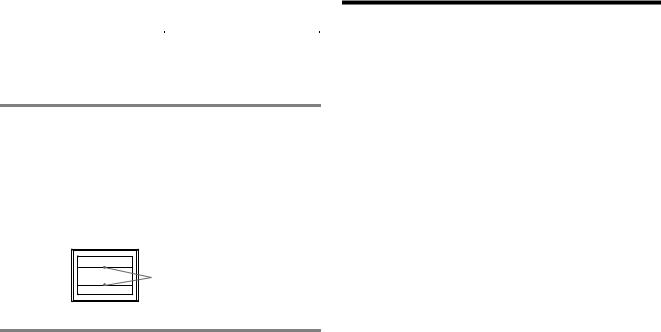
Affichage de l’identification du moniteur, du numéro de série et de la date de fabrication.
Alors que l’écran reçoit un signal |
I NFORMAT I ONS |
|
|||
vidéo, maintenez la touche |
|
|
|
|
|
MENU enfoncé pendant plus de |
MODEL : GDM |
|
F520 |
W |
|
|
|||||
5 secondes pour afficher les |
SER NO : 1234567 |
R |
|||
G |
|||||
informations sur ce moniteur. |
MANUFACTURED : 2000-52 |
||||
B |
|||||
|
|
|
|||
Si des lignes fines apparaissent à
l’écran (fils d’amortissement)
Ces lingnes ne constituent aucunement un dysfonctionnement; elles résultent de l’utilisation du tube image Trinitron sur ce moniteur. Ces lignes sont en fait l’ombre des fils d’amortissement employés pour stabiliser la grille d’ouverture. Cette grille est un composant essentiel qui rend le tube d’image Trinitron unique en laissant passer une plus grande quantité de lumière vers l’écran, permettant ainsi d’obtenir une image plus lumineuse et plus détaillée.
Fils d’amortissement
Fonction d’auto-diagnostic
Ce moniteur est équipé d’une fonction d’auto-diagnostic. En cas de problème avec le moniteur ou les ordinateurs, rien n’est affiché à l’écran et 1’indicateur ! (alimentation) s’allume en vert ou clignote en orange. Si l’indicateur ! (alimentation) est allumé en orange, l’ordinateur est en mode d’économie d’énergie. Essayez d’appuyer sur une touche ou de déplacer la souris.
x Si l’indicateur ! (alimentation) s’allume en vert
1Débranchez toutes les prises des connecteurs d’entrée vidéo 1 et 2, ou mettez les ordinateurs connectés hors tension.
2Eteignez puis rallumez le moniteur.
3Maintenez le bouton de commande vers le haut pendant quelques secondes avant que le moniteur n’entre en mode d’économie d’énergie.
Si les quatre barres de couleurs apparaissent (blanc, rouge, vert et bleu), le moniteur fonctionne correctement. Reconnectez les câbles d’entrée vidéo et vérifiez l’état des ordinateurs.
Si les barres de couleur n’apparaissent pas, il est possible que le moniteur ne fonctionne pas normalement. Informez votre revendeur Sony agréé de l’état du moniteur.
x Si l’indicateur ! (alimentation) clignote en orange
Eteignez puis rallumez le moniteur.
Si l’indicateur ! (alimentation) est allumé en vert, le moniteur fonctionne correctement.
Si l’indicateur ! (alimentation) clignote toujours, il est possible que le moniteur ne fonctionne pas normalement. Comptez le nombre de secondes entre les clignotements oranges de l’indicateur
! (alimentation) et informez votre revendeur Sony agréé de l’état du moniteur. Notez soigneusement le modèle et le numéro de série du moniteur. Notez également la marque et le modèle de l’ordinateur et de la carte graphique.
Spécifications
CRT |
|
|
Pas d’ouverture de grille de 0,22 mm, Déflexion de 90 degrés, FD |
|
|
Trinitron |
|
|
GDM-F520 |
21 pouces en diagonale |
|
GDM-F420 |
19 pouces en diagonale |
|
Taille de l’image affichée |
|
|
GDM-F520 |
Environ 403,8 × 302,2 mm (l/h) (16 × 12 pouces) |
|
|
Zone de visualisation de 19,8" |
|
GDM-F420 |
Environ 365 × 274 mm (l/h) (14 3/8 × 10 7/8 pouces) |
|
|
Zone de visualisation de 18,0" |
|
Résolution (H:Horizontal, V:Vertical) |
|
|
GDM-F520 |
Maximum H: 2048 points, V: 1536 lignes |
|
|
Recommandé H: 1600 points, V: 1200 lignes |
|
GDM-F420 |
Maximum H: 1920 points, V: 1440 lignes |
|
|
Recommandé H: 1280 points, V: 1024 lignes |
|
Niveaux des signaux d’entrée |
|
|
Signal vidéo: |
RVB analogique : 0,700 Vcc (positif), 75 Ω |
|
Signal SYNC: H/V séparé ou sync composite: |
|
|
|
TTL 2 kΩ, sans polarité |
|
|
Sync sur Vert : 0,3 Vcc (négatif) |
|
Zone d’image standard |
|
|
GDM-F520 |
Environ 388 × 291 mm (4:3) |
|
|
(15 3/8 × 11 1/2 pouces) ou |
|
|
Environ 364 × 291 mm (5:4) |
|
|
(14 3/8 × 11 1/2 pouces) |
|
GDM-F420 |
Environ 352 × 264 mm (4:3) |
|
|
(13 7/8 × 10 1/2 pouces) ou |
|
|
Environ 330 × 264 mm (5:4) |
|
|
(13 × 10 1/2 pouces) |
|
Fréquence de déflexion (H:Horizontal, V:Vertical) |
|
|
GDM-F520 |
H: 30 à 137 kHz, V: 48 à 170 Hz |
|
GDM-F420 |
H: 30 à 115 kHz, V: 48 à 170 Hz |
|
Voltage d’entrée secteur |
FR |
|
|
100 à 240 V, 50 – 60 Hz, 2,0 – 1,0 A |
|
|
|
|
Consommation électrique (sans périphérique USB connecté) |
|
|
GDM-F520 |
Environ 145 W |
|
GDM-F420 |
Environ 135 W |
|
Température d’utilisation |
|
|
|
10°C à 40°C |
|
Dimensions |
Environ 497 × 499 × 487 mm (l/h/p) |
|
GDM-F520 |
|
|
|
(19 5/8 × 19 3/4 × 19 1/4 pouces) |
|
GDM-F420 |
Environ 446 × 472 × 463 mm (l/h/p) |
|
|
(17 5/8 × 18 5/8 × 18 1/4 pouces) |
|
Poids
GDM-F520 Environ 30 kg (66 lb 2 oz)
GDM-F420 Environ 26 kg (57 lb 5 oz)
Plug and Play DDC2B/DDC2Bi
Accessoires fournis Cordon d’alimentation
Câble de signal vidéo HD15
Câble USB
Adaptateur Power Mac G3/G4
Le présent mode d’emploi
(suite page suivante)
7
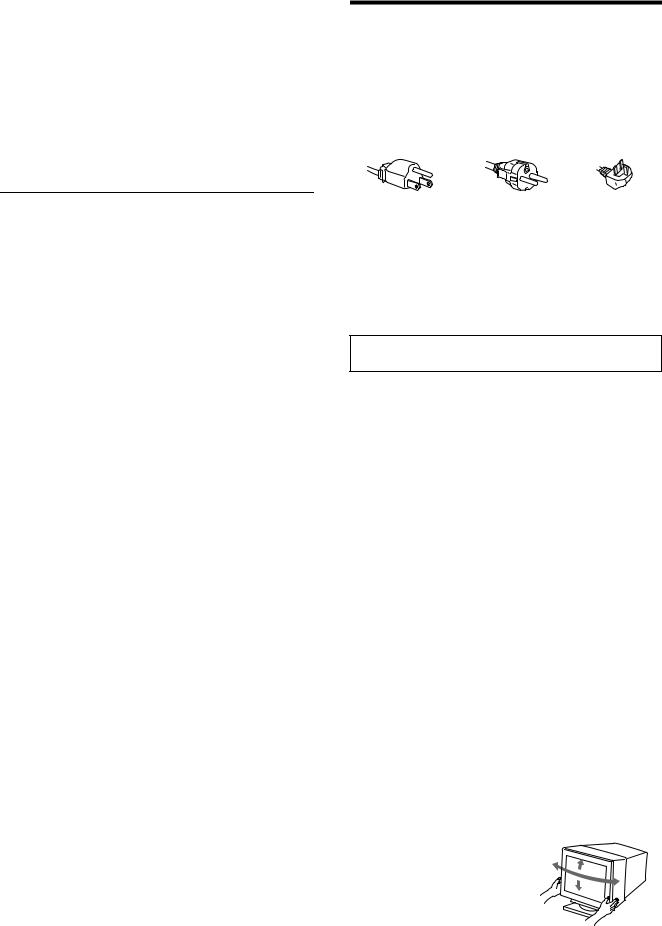
Modes préréglés et personnalisés
Lorque le moniteur reçoit un signal d’entrée, il compare automatiquement le signal à l’un des modes préréglés d’usine mémorisés afin de fournir une image de haute qualité (voir le tableau de modes prédéfinis (Preset mode timing table) page i). Si le signal d’entrée ne correspond à aucun des modes préréglés d’usine, le moniteur fournit automatiquement l’image la plus appropriée à ce signal d’entrée, dans la plage de fréquences verticales ou horizontales (page 7), selon la formule de minutage généralisée. Lorsque l’image est réglée, les données de réglage sont mémorisées comme un mode utilisateur et sont automatiquement utilisées dès qu’un signal d’entrée identique est reçu.
Fonction d’économie d’énergie
Ce moniteur satisfait aux critères d’économie d’énergie VESA, TCO’99 et ENERGY STAR. Lorsqu’aucun signal n’est envoyé à l’ordinateur par l’ordinateur, le moniteur réduit automatiquement la consommation d’énergie comme indiqué ci-dessous.
Mode |
Consommation |
indicateur |
d’alimentation |
électrique*1 |
! (alimentation) |
fonctionnement |
≤ 145 W (GDM-F520) |
vert |
normal |
≤ 135 W (GDM-F420) |
|
|
|
|
inactif*2 |
≤ 3 W |
orange |
(sommeil profond)*3 |
|
|
*1 Ces chiffres indiquent la consommation électrique lorsqu’aucun périphérique USB n’est connecté à l’ordinateur.
*2 PAS DE VIDEO s’affiche à l’écran lorsque votre ordinateur passe en mode d’économie d’énergie. Le moniteur passe en mode d’économie d’énergie quelques secondes plus tard.
*3 “Sommeil profond” est le mode d’économie d’énergie défini par l’agence de protection de l’environnement.
La conception et les spécifications sont sujettes à modifications sans préavis.
Précautions
Avertissement relatif au raccordement secteur
•Utilisez le cordon d’alimentation fourni. Si vous utilisez un cordon d’alimentation différent, assurez-vous que ce dernier est compatible avec votre réseau d’alimentation électrique.
Pour les utilisateurs au Royaume-Uni
Si vous utilisez le moniteur au Royaume-Uni, assurez-vous d’utiliser le cordon d’alimentation correct.
Exemple de types de prises
pour 100 à 120 V CA |
pour 200 à 240 V CA |
pour 240 V CA |
|
|
uniquement |
•Avant de débrancher le cordon d’alimentation, attendez au moins 30 secondes avant de couper l’alimentation afin de permettre le déchargement de l’électricité statique de la surface de l’écran.
•Après la mise sous tension, l’écran est démagnétisé pendant quelques secondes. Ceci génère un champ magnétique puissant autour de l’écran, susceptible d’altérer les données stockées sur les cassettes ou bandes placées à proximité du moniteur. Assurez-vous de ne pas placer d’équipement d’enregistrement magnétique, de bandes ou de disquettes à proximité du moniteur.
La prise électrique doit être installée à proximité de l’appareil et facile d’accès.
Installation
N’installez pas le moniteur dans les endroits suivantes:
•sur des surfaces textiles (tapis, couvertures, etc.) ni à proximité de tissus (rideaux, draperies) qui risquent d’obstruer les orifices de ventilation
•près de sources de chaleur telles que des radiateurs ou des conduits d’air chaud ou à un emplacement exposé aux rayons directs du soleil
•dans un endroit sujet à de fortes variations de température
•dans un endroit sujet à des vibrations mécaniques ou à des chocs
•sur une surface instable
•près d’un équipement générant un champ magnétique, tel qu’un transformateur ou des lignes à haute tension
•près ou sur une surface métallique chargée d’électricité
•dans un rack fermé
Entretien
•Nettoyez l’écran en utilisant un chiffon doux et sec. Si vous utilisez un nettoyant pour vitres, n’utilisez pas de produits contenant une solution antistatique ou une solution similaire qui risque d’abîmer le revêtement de l’écran.
•Ne frottez pas, ne touchez pas et ne tapotez pas la surface de l’écran avec des objets pointus ou abrasifs, tels que la pointe d’un stylo ou un tournevis. Dans le cas contraire, vous pourriez rayer le tube de l’écran.
•Nettoyez le châssis, l’écran et les commandes à l’aide d’un chiffon doux légèrement imbibé d’une solution détergente non agressive. N’utilisez pas d’éponge abrasive, de poudre à récurer ou de solvant tel que de l’alcool ou de la benzine.
Transport
Lorsque vous transportez ce moniteur, utilisez le carton et les matériaux d’emballage d’origine.
Support d’écran
Ne retirez pas le support de moniteur.
Utilisation du pied pivotant |
|
|
|
Ce moniteur peut être ajusté selon les |
|
|
|
angles illustrés ci-contre. Pour |
90° |
15° |
|
tourner le moniteur verticalement ou |
|||
|
|||
|
90° |
||
horizontalement, tenez sa base avec |
|
5° |
|
les deux mains. |
|
||
|
|
8
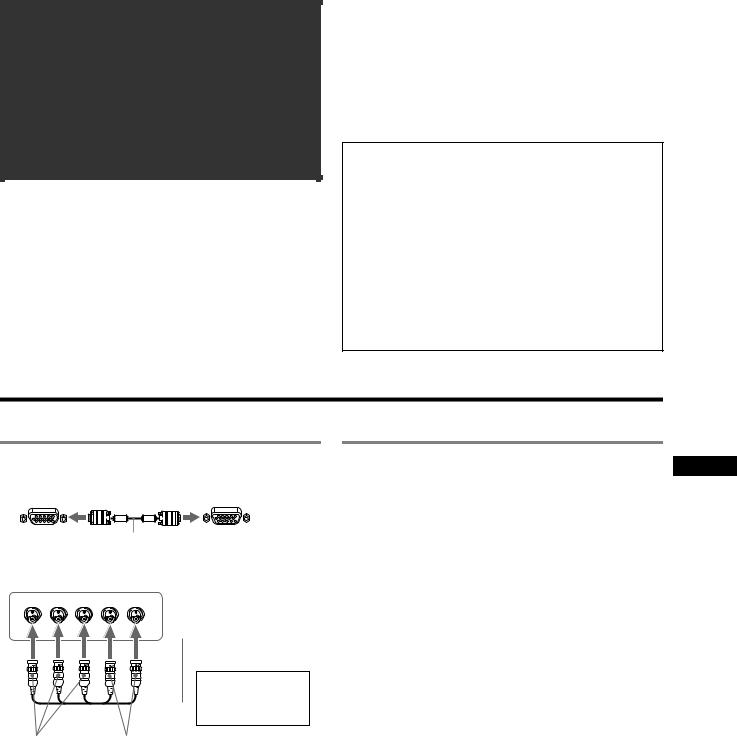
Inhalt |
|
Anschließen des Monitors . . . . . |
. . . . . . . . . . . . . . . 3 |
Einstellen des Monitors . . . . . . . |
. . . . . . . . . . . . . . . 4 |
Störungsbehebung . . . . . . . . . . . |
. . . . . . . . . . . . . . . 6 |
Technische Daten . . . . . . . . . . . . |
. . . . . . . . . . . . . . . 7 |
Sicherheitsmaßnahmen . . . . . . . |
. . . . . . . . . . . . . . . 8 |
Appendix . . . . . . . . . . . . . . . . . . . |
. . . . . . . . . . . . . . . . i |
Preset mode timing table . . . . . . |
. . . . . . . . . . . . . . . . . i |
TCO’99 Eco-document . . . . . . . . |
Hintere Umschlagseite |
•Trinitronâ ist ein eingetragenes Warenzeichen der Sony Corporation.
•Macintosh ist ein Warenzeichen der Apple Computer, Inc., in den USA und anderen Ländern.
•Windowsâ und MS-DOS sind eingetragene Warenzeichen der Microsoft Corporation in den USA und anderen Ländern.
•IBM PC/AT und VGA sind eingetragene Warenzeichen der IBM Corporation in den USA.
•VESA und DDCä sind Warenzeichen der Video Electronics Standard Association.
•ENERGY STAR ist ein eingetragenes Warenzeichen in den USA.
•Alle anderen in diesem Handbuch erwähnten Produktnamen können Warenzeichen oder eingetragene Warenzeichen der jeweiligen Eigentümer sein.
•Im Handbuch sind die Warenzeichen und eingetragenen Warenzeichen nicht überall ausdrücklich durch „ä“ und „â“ gekennzeichnet.
Hinweis
Dieses Gerät erfüllt bezüglich tieffrequenter (very low frequency) und tiefstfrequenter (extremely low frequency) Strahlung die Vorschriften des „Swedish National Council for Metrology (MPR)“ vom Dezember 1990 (MPR II).
Dieses Garät entspricht den folgenden europäischen EMVVorschriften für Betrieb in Wohngebieten, gewerblicher Gebleten und Leichtindustriegebieten.
EN55022/1998 Klasse B EN55024/1998 EN61000-3-2/1995
Hinweise
•Aus ergonomischen Gründen wird empfohlen, die Grundfarbe Blau nicht auf dunklem Untergrund zu verwenden (schlechte Erkennbarkeit, Augenbelastung bei zu geringem Zeichenkontrast).
•Aus ergonomischen Gründen (flimmern) sollten nur Darstellungen bei Vertikalfrequenzen ab 70 Hz (ohne Zeilensprung) verwendet werden.
•Die Konvergenz des Bildes kann sich auf Grund des Magnetfeldes am Ort der Aufstellung aus der korrekten Grundeinstellung verändern. Zur Korrektur empfiehlt es sich deshalb, die Regler an der Frontseite für Konvergenz so einzustellen, daß die getrennt sichtbaren Farblinien für Rot, Grün und Blau bei z.B. der Darstellung eines Buchstabens zur Deckung (Konvergenz) gelangen.
Siehe hierzu auch die Erklärungen zu Konvergenz.
Anschließen des Monitors
1Anschließen des Monitors an den Computer
x Anschließen an einen HD15-Eingang
an HD15 |
Videosignalkabel |
an HD15 des |
|
(mitgeliefert) |
anzuschließenden |
|
|
Computers |
x Anschließen an einen 5-BNC-Anschluß |
||
R G |
B HD VD |
|
|
|
Videosignalkabel |
|
|
(nicht mitgeliefert) |
Schließen Sie den 
 Monitor wie in den
Monitor wie in den  Beispielen oben gezeigt an den Computer an.
Beispielen oben gezeigt an den Computer an.
an VIDEO IN R/G/B |
an SYNC IN HD/VD |
Anschließen an einen Macintosh oder kompatiblen Computer
Wenn Sie diesen Monitor an einen Power Macintosh G3/G4 anschließen, verwenden Sie, wenn nötig, den mitgelieferten Adapter. Schließen Sie den mitgelieferten Adapter an den Computer an, bevor Sie das Kabel anschließen. Wenn Sie den Monitor an andere Modelle der Macintosh-Serie mit zwei Stiftreihen anschließen wollen, benötigen Sie einen anderen Adapter (nicht mitgeliefert).
2 Einschalten von Monitor und Computer
DE
1 Verbinden Sie das Netzkabel mit dem Monitor, und schalten Sie den Monitor am Netzschalter ! ein.
2 Schalten Sie den Computer ein.
Keine speziellen Treiber erforderlich
Dieser Monitor entspricht dem Plug-and-Play-Standard „DDC“, so daß alle Daten des Monitors automatisch erkannt werden. Daher muß kein spezifischer Treiber auf dem Computer installiert werden.
Wenn Sie den Monitor an den PC anschließen und diesen dann zum ersten Mal starten, wird möglicherweise der Hardware-Assistent auf dem Bildschirm angezeigt. Gehen Sie in diesem Fall nach den Anweisungen auf dem Bildschirm vor. Der Plug-and-Play-Monitor ist automatisch ausgewählt, so daß Sie ohne weitere Vorbereitungen mit diesem Monitor arbeiten können.
Hinweise
•Nur der HD15-Anschluß ist Plug-and-Play-kompatibel (DDC-kompatibel), nicht jedoch der 5-BNC-Anschluß.
•Berühren Sie nicht die Stifte am Stecker des Videosignalkabels.
•Achten Sie darauf, den Stecker des Videosignalkabels korrekt am HD15Anschluß auszurichten, damit die Stifte am Stecker des Videosignalkabels nicht verbogen werden.
Auswählen des Eingangssignals
Über den HD15und den BNC-Anschluß können Sie zwei Computer an diesen Monitor anschließen. Mit dem Schalter INPUT schalten Sie zwischen den beiden Computern um. Der ausgewählte Anschluß wird 3 Sekunden lang auf dem Bildschirm angezeigt.
Hinweis
Wenn am ausgewählten Eingang kein Signal eingespeist wird, erscheint KEIN SIGNAL auf dem Bildschirm. Nach einigen Sekunden schaltet der Monitor in den Energiesparmodus. Schalten Sie in diesem Fall zum anderen Eingang um.
(Fortsetzung)
3
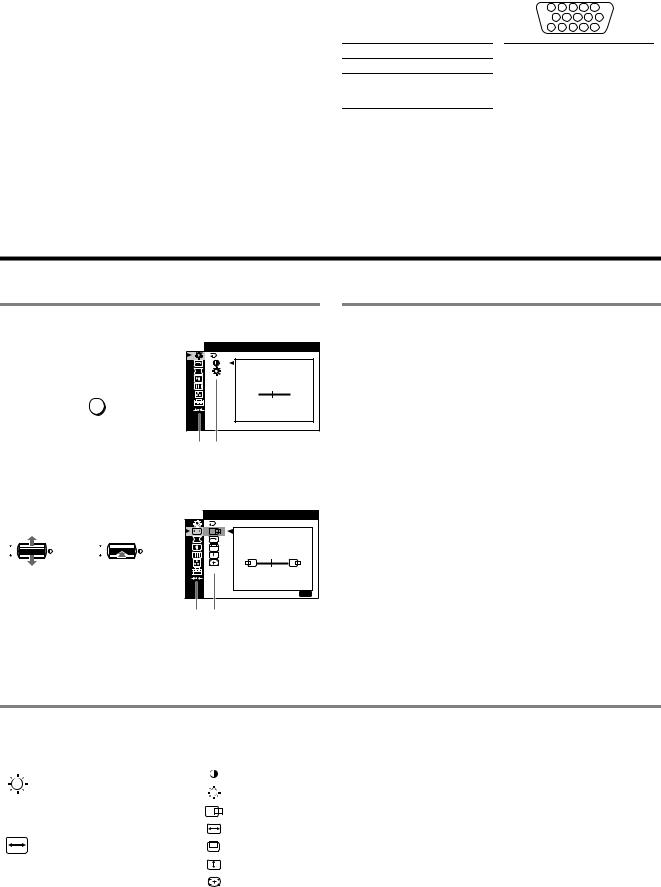
Anschließen von USB-kompatiblen Peripheriegeräten (USB - Universeller Serieller Bus)
Vergewissern Sie sich, daß Monitor und Computer eingeschaltet sind, und schließen Sie den Computer dann an die USB-Anschlüsse (
 ) an der rechten Seite des Monitors an.
) an der rechten Seite des Monitors an.
Schließen Sie Ihren Computer mit dem mitgelieferten USB-Kabel an den quadratischen USB-Anschluß ( ) für das vorgeschaltete Gerät an.
) für das vorgeschaltete Gerät an.
Wenn eine Windows-Meldung auf Ihrem Bildschirm erscheint, gehen Sie nach den Anweisungen auf dem Bildschirm vor, und wählen Sie „Generic USB Hub“.
Wenn Sie USB-kompatible Peripheriegeräte (z. B. Drucker, Tastatur, Maus, Scanner usw.) anschließen wollen, verbinden Sie sie mit dem rechteckigen USB-Anschluß ( ) für nachgeschaltete Geräte.
) für nachgeschaltete Geräte.
Hinweis
Der Monitor fungiert als USB-Hub, wenn er eingeschaltet und betriebsbereit ist oder sich im Energiesparmodus befindet.
HD15-Eingänge |
5 |
|
4 |
3 |
2 |
1 |
• |
10 |
9 |
8 |
7 |
6 |
|
|
||||||
|
15 |
14 |
13 12 |
11 |
||
Stift Nr. |
Signal |
1Rot
2Grün (Grünsignal mit Synchronisation)
3 |
Blau |
4 |
ID (Masse) |
|
|
5 |
DDC-Masse* |
|
|
6 |
Masse Rot |
|
|
7 |
Masse Grün |
|
|
8 |
Masse Blau |
|
|
9 |
DDC + 5V* |
|
|
Stift Nr. |
Signal |
10 |
Masse |
|
|
11 |
ID (Masse) |
|
|
12 |
Bidirektionale |
|
Daten (SDA)* |
|
|
13 |
H. Sync |
|
|
14 |
V. Sync |
|
|
15 |
Datentakt (SCL)* |
|
|
* DDC (Display Data Channel) ist ein Standard der VESA.
Einstellen des Monitors
Navigieren in den Menüs |
|
|
1 Rufen Sie mit der Taste |
KONTRAST / HELL |
|
MENU das Menü auf. |
|
|
|
|
|
|
|
KONTRAST |
MENU |
, |
50 |
|
||
|
|
1 0 2 4 x 7 6 8 / 8 5 H z |
|
Hauptmenü |
Untermenü |
2 Bewegen Sie die Steuertaste nach m/M, um das
Hauptmenü hervorzuheben, in dem Sie Einstellungen vornehmen wollen, und drücken Sie die Steuertaste.
|
|
|
GRÖSSE / B I LDLAGE |
OK |
, OK |
, |
|
|
|
|
45 |
|
|
|
ENDE : MENU |
|
|
Hauptmenü |
Untermenü |
3Wählen Sie das Untermenü aus, in dem Sie eine Einstellung vornehmen wollen, und drücken Sie die Steuertaste.
4Nehmen Sie die Einstellung mit der Steuertaste vor.
Einstellen der Bildqualität
(PICTURE EFFECT)
Sie können aus 3 voreingestellten Modi den am besten geeigneten Bildmodus auswählen. Drücken Sie dazu entsprechend oft die Taste PICTURE EFFECT.
x PROFESSIONELL
Für präzise und gleichbleibende Bildschirmfarben. Wählen Sie diese Einstellung für Desktop Publishing und Grafikanwendungen auf professionellem Niveau.
x STANDARD
Für kontraststarke, helle Bilder. Diese Einstellung eignet sich für die meisten gängigen Anwendungen wie Tabellenkalkulationen, Textverarbeitungsprogramme, E-Mail-Programme oder das Surfen im Internet.
x DYNAMISCH
Für sehr lebhafte, fotorealistische Bilder. Heller als der Modus „STANDARD“. Wählen Sie diese Einstellung für grafikbetonte Unterhaltungs-Software wie zum Beispiel Spiele oder für die Wiedergabe von DVDs.
Einstellungen über das Bildschirmmenü
Hauptmenüsymbole und |
Untermenüsymbole und Einstelloptionen |
||
Einstelloptionen |
|
|
|
|
Einstellen von Kontrast und |
|
Kontrast |
|
|
|
|
|
Helligkeit*1 |
|
Helligkeit |
|
|
|
|
|
|
|
|
|
|
|
Horizontale Position |
|
|
|
|
|
|
|
Breite |
|
Einstellen von Größe oder Zentrierung |
|
|
|
|
Vertikale Position |
|
|
des Bildes*1 |
|
|
|
|
|
|
|
|
|
Höhe |
|
|
|
|
|
|
|
Automatische Einstellung von Bildgröße und -zentrierung |
|
|
|
|
4
